This classic Masala dosa recipe makes perfectly light, soft and crispy crepes stuffed with a savory, wonderfully spiced potato and onion filling. It might take a bit of time to make delicious hotel style masala dosa, but with my step-by-step instructions and photos I promise it will be easier than you think and is so worth the effort!
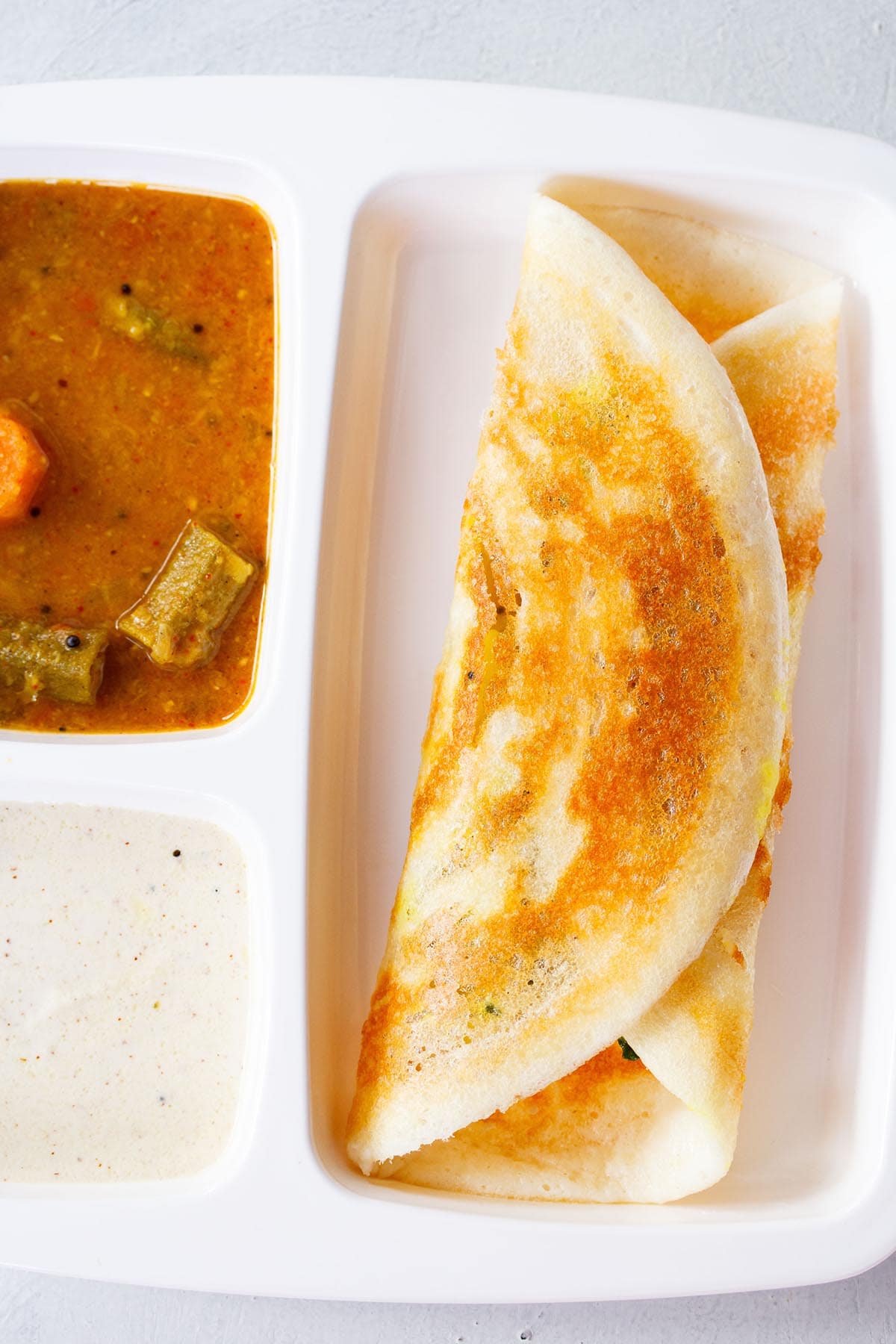
About Masala Dosa Recipe
While masala dosa is a famous snack most popular in South India, these tasty stuffed crepes are enjoyed in North India as well and can be found on menus throughout the world.
Masala dosa are crispy, soft, savory and healthy crepes made with a rice and lentil batter. The dosa are gluten-free and dairy-free, with a sturdy yet soft texture that’s great for holding a hearty homemade potato filling.
To make the batter, lentils and rice are soaked for several hours and then blended together. This makes a creamy and smooth batter. This rice and lentil batter is fermented overnight to create just the right tangy flavor and tender, light crepes.
Dosa Batter is quickly cooked like a thin pancake on a hot griddle, with your choice of oil or butter or ghee. The crepe is then filled with a spiced potato and onion filling, and served with Sambar and Coconut Chutney.
You can easily customize this recipe to fit your tastes by adding grated paneer, cheese, extra veggies (like peas, carrots, cauliflower, and/or green beans) to the potato filling, and serving with other favorite dipping sauces or side dishes.
Getting hungry? Here I share with you step-by-step photos and instructions for making the best restaurant-quality masala dosa recipe from scratch. This recipe is fun to serve for breakfast, brunch or dinner with friends, and much of the prep work can be done in advance!
My easy recipe for hotel style masala dosa features 4 main steps you’ll find below:
- Blending the lentil and rice batter
- Fermenting batter
- Preparing the savory potato masala filling
- Assembling the complete masala dosa dish
How to make Masala Dosa
1. Make Batter
1. First take all the ingredients in three bowls. Note that these ingredients are easily available online or any Indian or Asian grocery store if you live outside India.
- 1.5 cups idli rice or parboiled rice in one bowl. You can also use regular short-grained to medium-grained rice like sona masuri or parmal.
- ½ cup urad dal (husked black gram) + 1 tablespoon chana dal (husked and split bengal gram) + 20 methi seeds (fenugreek seeds) in a second bowl
- ⅓ cup thick poha (flattened rice) in a third bowl.
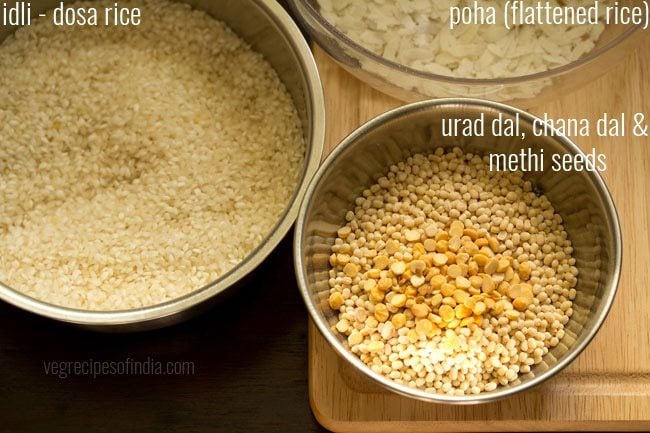
2. Rinse the lentils and fenugreek seeds a couple of times. Then soak them in 1 cup water for 4 to 5 hours.
Tip: Ensure to use urad dal that are fresh and within their shelf-period.
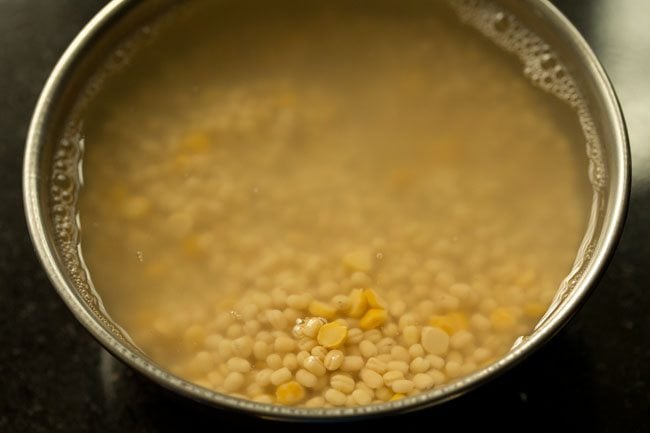
3. Rinse the rice a couple of times and keep aside.
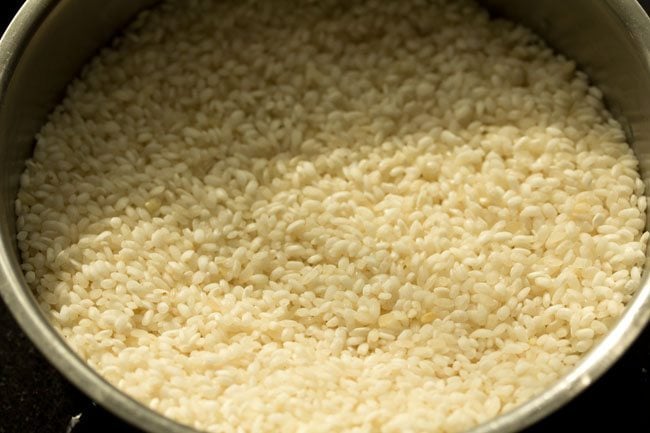
4. Rinse flattened rice once or twice and then add to the rice.
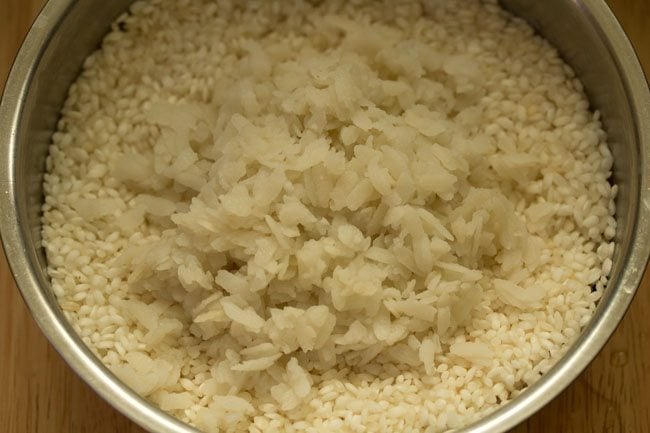
5. Pour 2 cups water. Stir and soak both rice and flattened rice together for 4 to 5 hours.
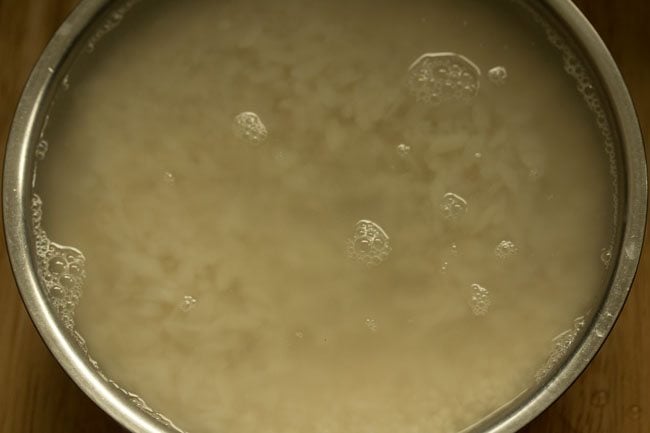
6. Before grinding, strain the water from the soaked lentils+fenugreek seeds and keep it for grinding urad dal. You can also use fresh water if you prefer.
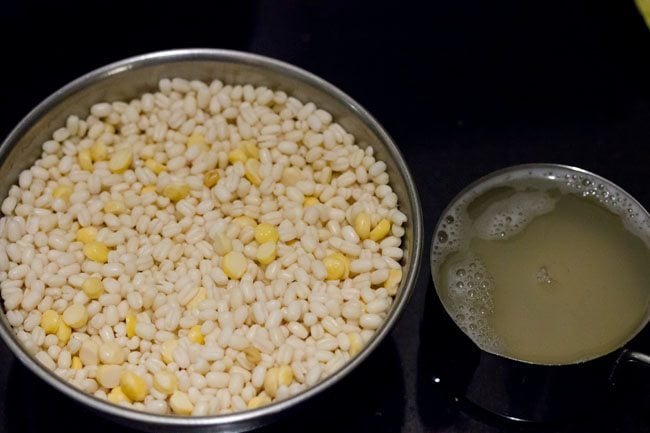
7. Add the lentils in the grinder jar. Also add ½ cup of the soaked and strained water to the lentils or ½ cup of fresh water if you like.
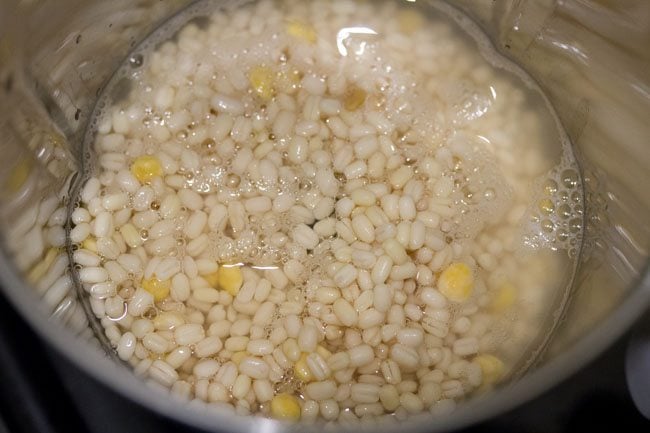
8. Grind the urad dal, chana dal and fenugreek seeds till you get a batter which is light and fluffy. The urad dal has to be ground really well, so that the dosa batter ferments well.
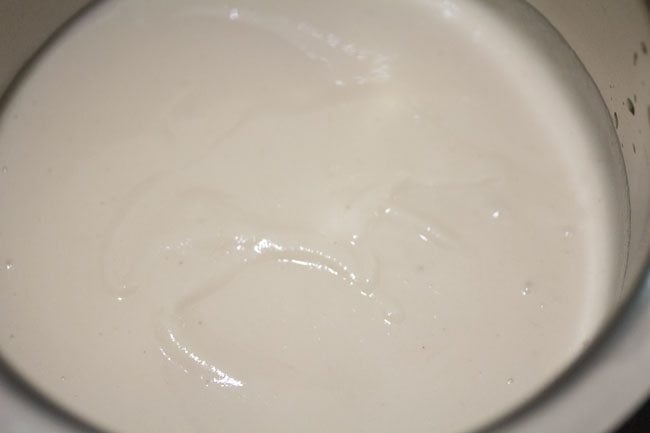
9. Remove batter in a bowl or pan with a spatula. Below is a photo showing the consistency of the urad dal batter.
Note that a well ground and fluffy urad dal batter helps in the fermentation process.
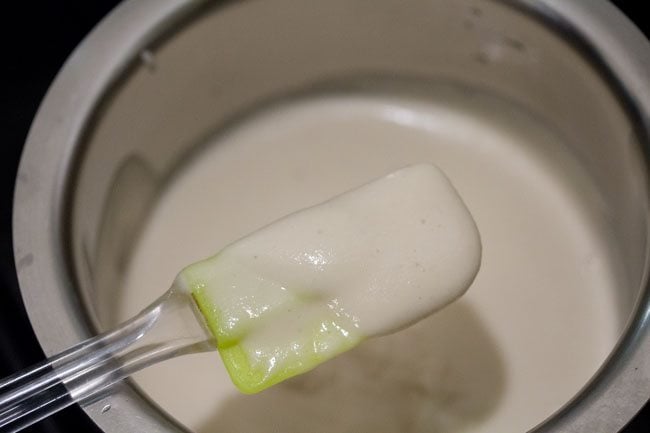
10. Strain the rice well. Then in the same grinder, add the soaked rice and 1 cup fresh water. You can grind rice in one batch or in two to three batches. This will depend on the size of the grinder jar.
I ground in one batch and added 1 cup water for grinding. You can even add ¾ cup water while grinding. Addition of water will depend on the quality of rice. So you may need to add less or more water.
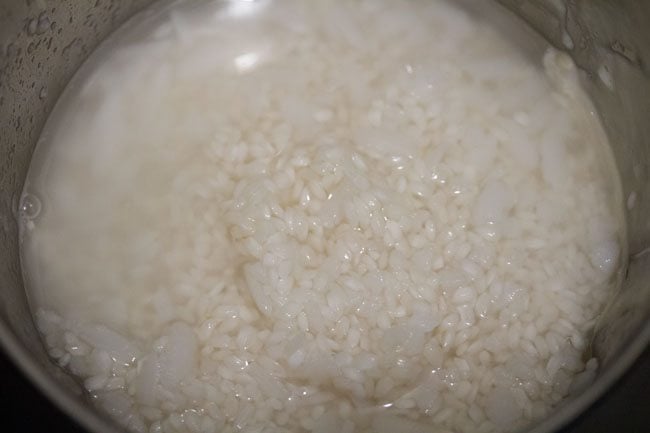
11. Grind the rice till you get a fine grainy consistency in it. The rice batter should have a fine rava (cream of wheat) like consistency of the ground rice grains.
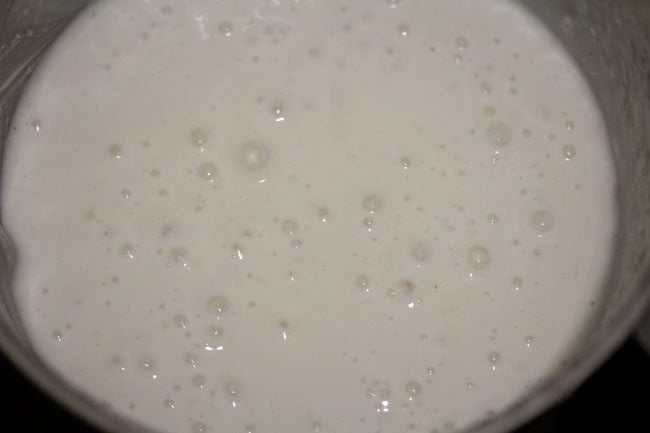
12. Now pour the rice+flattened rice batter in the same pan or bowl containing the urad lentil batter.
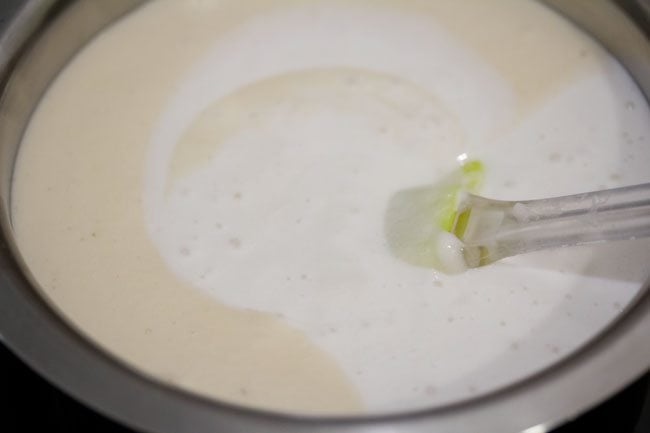
13. Add ½ teaspoon edible rock salt or add as per taste. You can also use sea salt or pink salt.
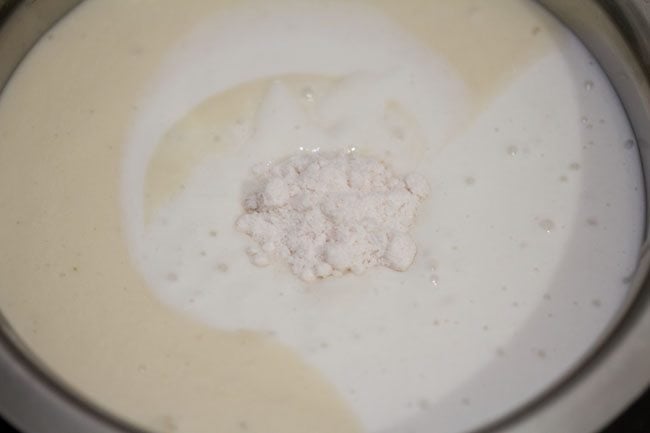
2. Ferment Batter
14. Mix the salt very well with the ground batter. Also, mix both the rice batter and the urad lentil batter thoroughly. Cover with a lid and keep aside to ferment for 8 to 9 hours at room temperature.
You can keep for less or more time and this will depend on the temperature conditions in your city. It can take anywhere from 6 hours to a day or more for it to ferment.
In the Indian summers, the batter ferments quickly and during winters it takes a longer duration of time.
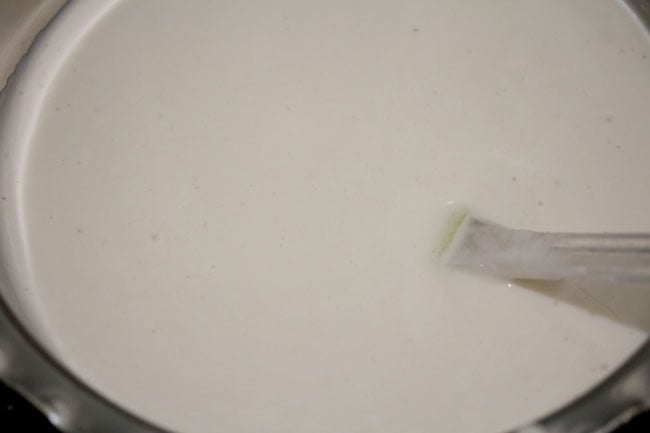
15. In the below photo, you see a well fermented batter the next day. I kept for about 13 hours and 35 minutes at room temperature, as it is cooler during the monsoons where we live.
If you live in a cold place, keep your batter in a lit (but not heated) oven or keep near a warm place.
You can also use the yogurt setting of your Instant Pot to ferment. Use the “low” option when using the yogurt setting as the “medium” option will cook the batter instead of fermenting it. Cover with a separate lid and not the Instant pot lid as it can get locked.
For fermenting batter in the instant pot, time will vary from 8 to 12 hours depending on your room temperature, season, altitude and geographical location.
During winters and cooler days, I always use the instant pot for fermenting dosa batter and it works like a charm.
A well fermented batter will double or triple in volume, have a pleasant sour aroma with many tiny air-pockets.
Once your batter is nicely fermented, cover and refrigerate it when you start to make the potato masala stuffing. In hotter seasons, the batter kept at room temperature will continue to ferment and will become very sour.
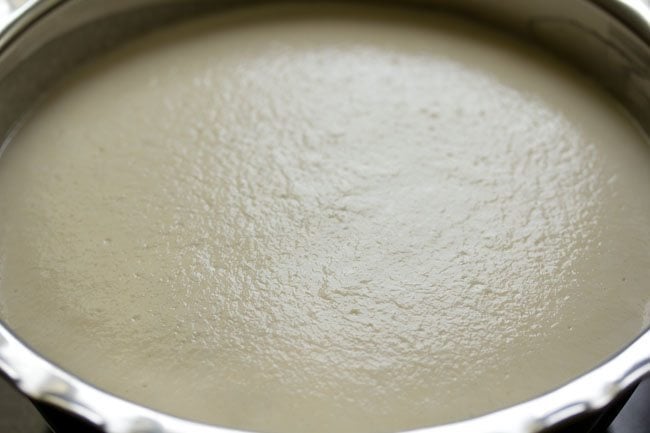
3. Make Potato Filling
1. First rinse and then boil 4 medium sized potatoes in 2 cups water for 5 to 6 whistles in a pressure cooker.
You can also boil potatoes in a pan or in an Instant pot. The potatoes have to be completely cooked and fork tender.
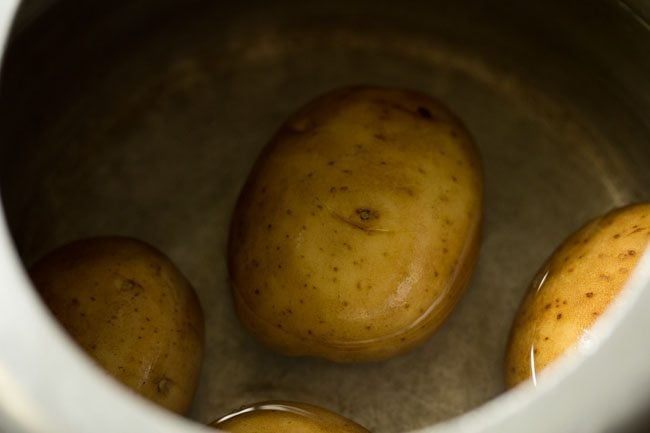
2. When the potatoes are cooking, rinse and soak 1 tablespoon chana dal in ¼ cup hot water for 30 minutes. Then drain all the water from the chana dal and set aside.
If you are out of chana dal, then simply skip it.
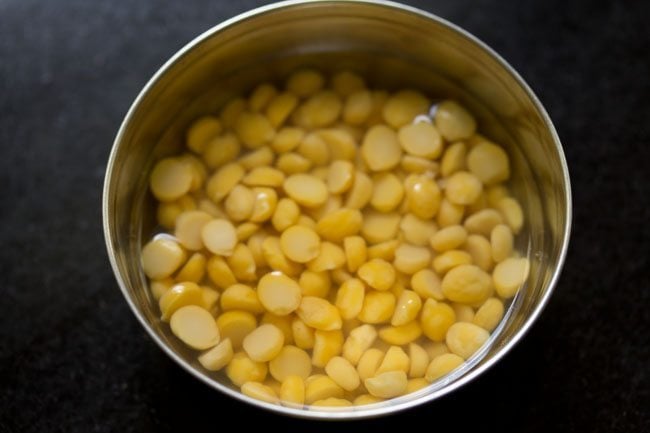
3. When the pressure settles down on its own in the cooker, remove the lid. Drain the potatoes and let them become warm.
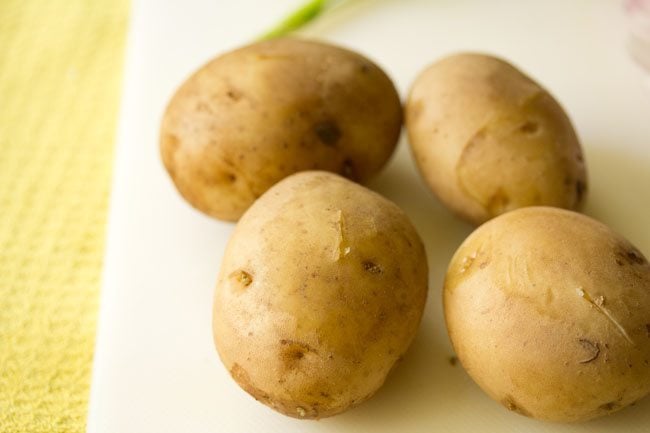
4. Then peel and chop them. Also, thinly slice 2 medium to large onions (200 grams) and chop 1 to 2 green chilies, finely chop 1 inch ginger and some coriander leaves. When you measure, you should have:
- 1.25 cups thinly sliced onions
- 1 teaspoon chopped green chillies
- 1 teaspoon finely chopped ginger
- 3 tablespoons chopped coriander leaves
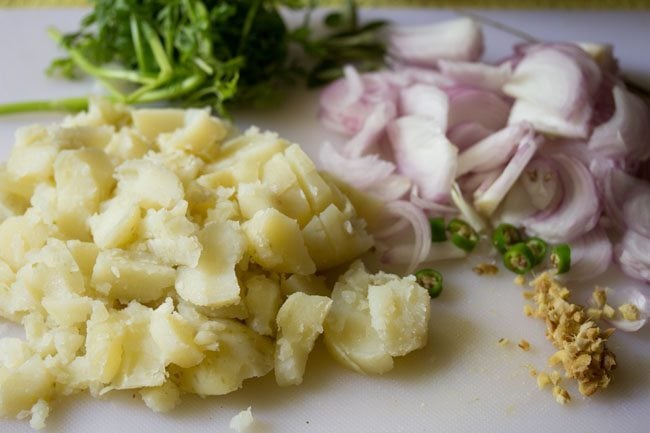
5. Heat oil or ghee in a frying pan or skillet. If using cashews, then fry 2 tablespoons cashews at this step and keep them aside.
Lower the heat and add mustard seeds and let them splutter. You can add ½ teaspoon cumin seeds while tempering.
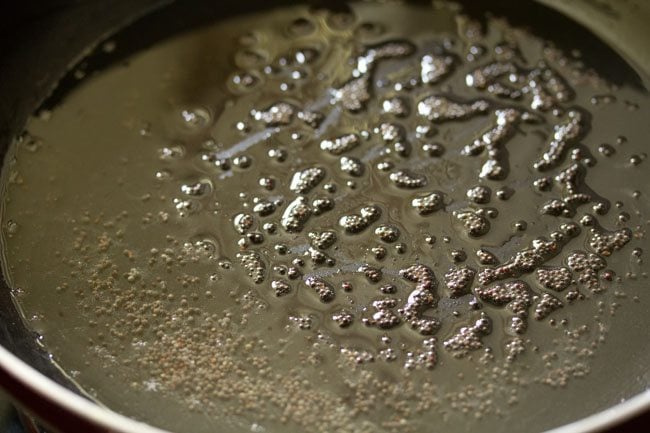
6. Then add the chana dal.
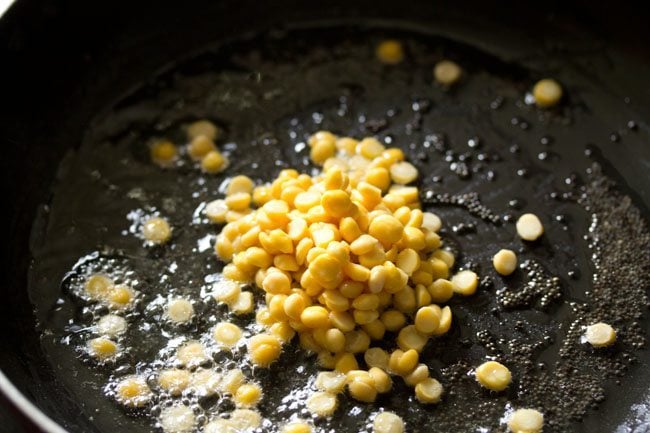
7. Saute the chana dal for 2 to 3 minutes on a low heat or till they turn light golden or golden.
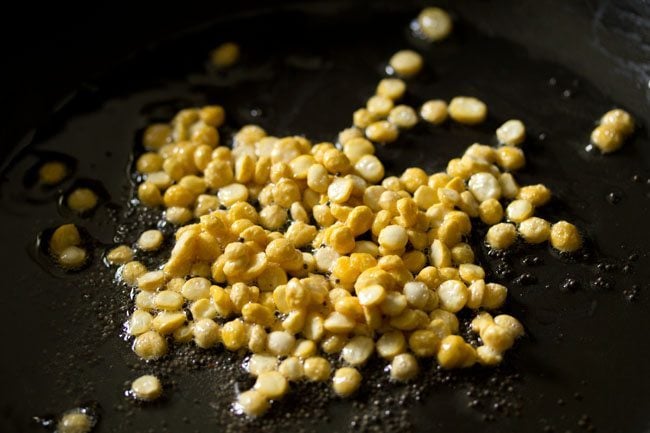
8. Now add the sliced onions, curry leaves, green chilies and ginger.
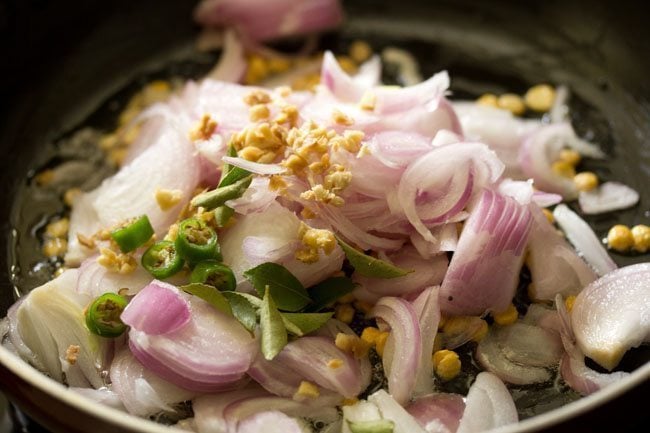
9. Sauté the onions till they soften and turn translucent. Stir often while sautéing onions so that they get evenly cooked.
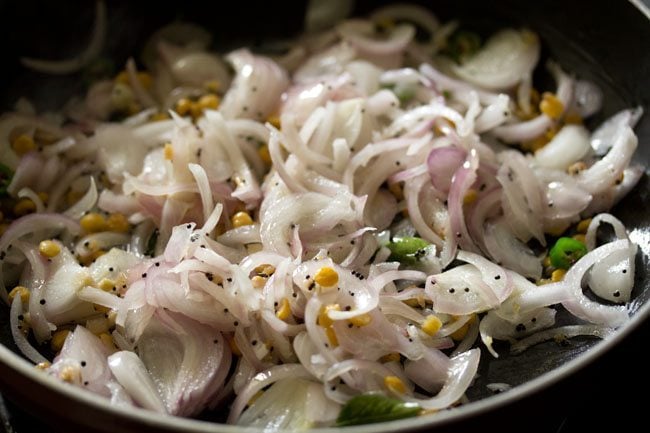
10. Add the turmeric powder and asafoetida (hing). To make it gluten-free use the gluten-free asafoetida or skip it altogether.
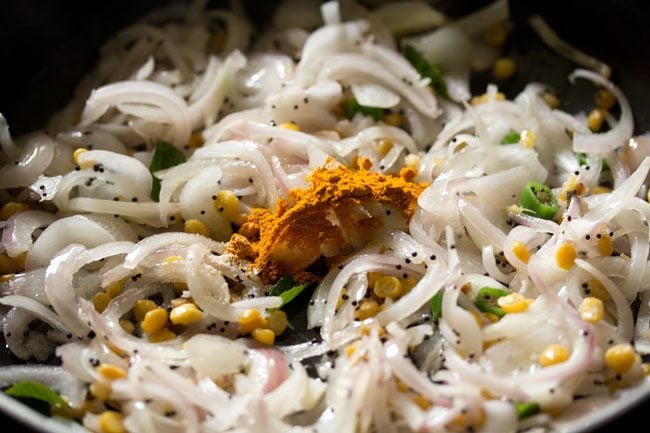
11. Mix very well.
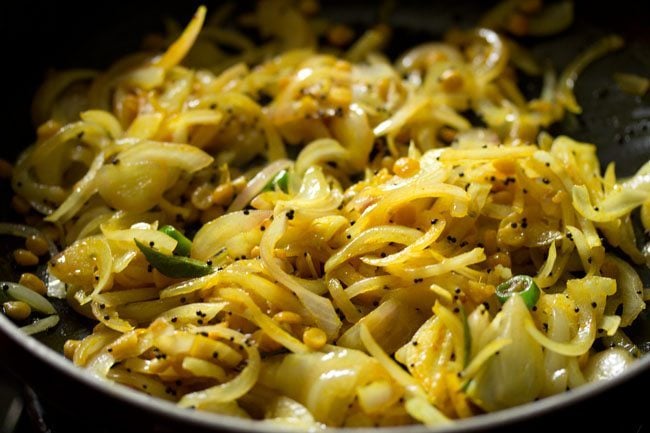
11. Now add ½ cup water.
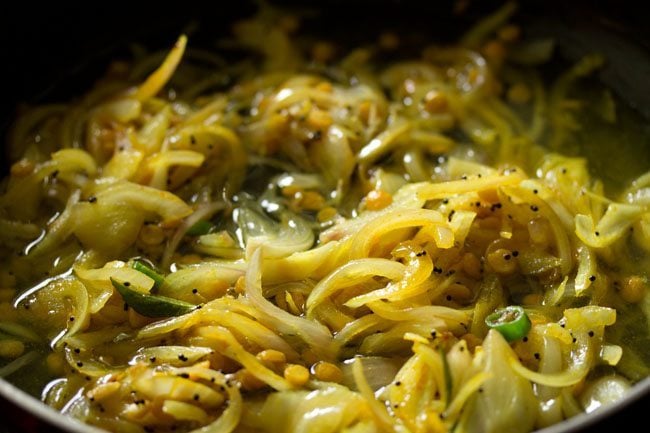
12. Again mix well and simmer for 2 to 3 minutes or till the mixture thickens a bit.
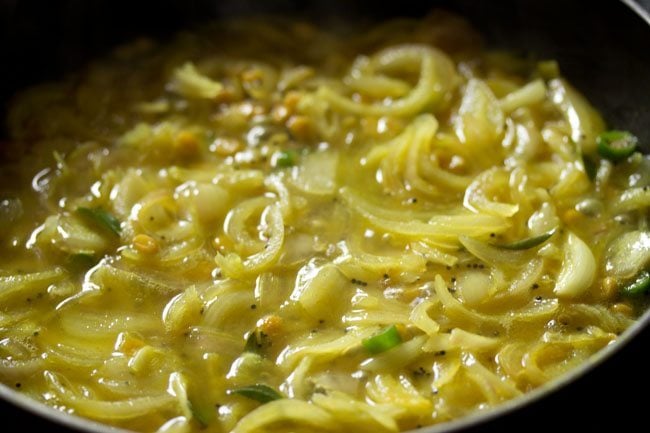
12. Next add the boiled chopped potatoes.
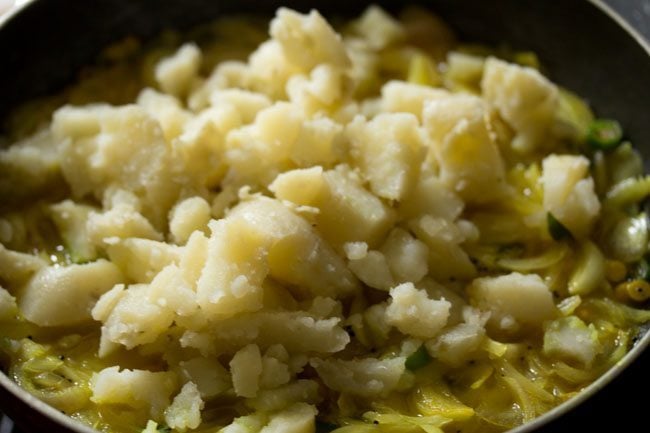
13. Mix very well. You can choose to mash the potatoes slightly while cooking.
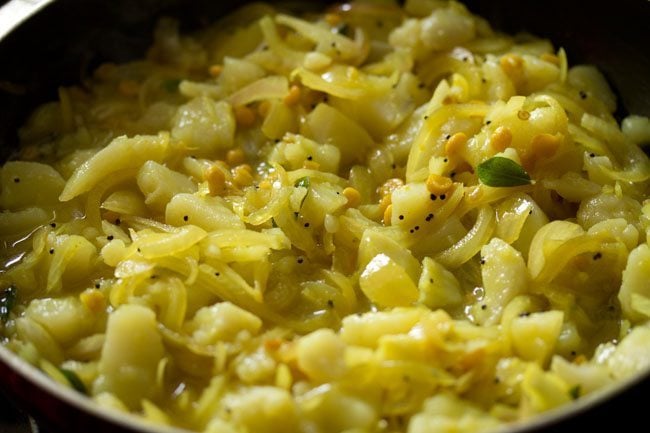
14. Season with salt according to taste. Also add ¼ to ½ teaspoon sugar for a slightly sweet taste. You can add more sugar if you prefer.
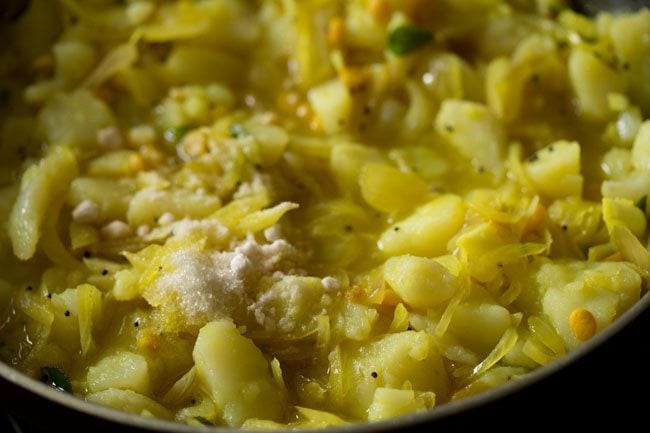
14. And stir again.
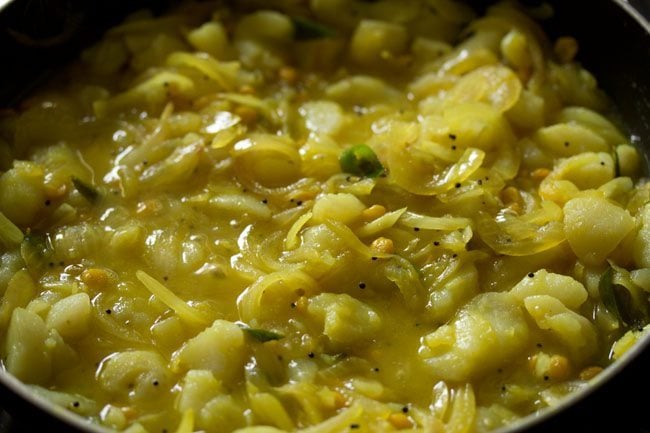
15. Simmer on a low to medium-low heat for 3 to 4 minutes stirring occasionally.
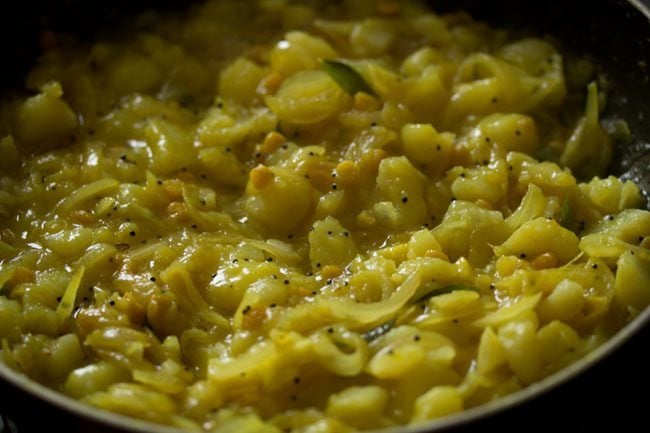
16. Switch off the heat and then add chopped coriander leaves. Also add fried cashews now (if you have fried the cashews earlier as mentioned in step 5 above). Mix well.
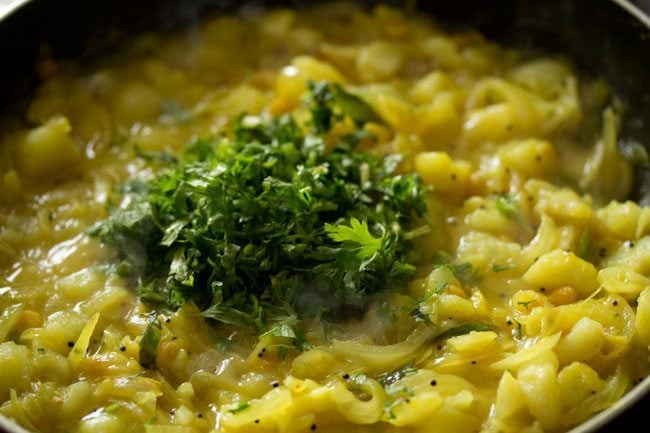
15. Stir and keep the potato masala aside. The potato filling should be moist and easily spreadable on the dosa. Make sure there is no water in the potato stuffing. It should not be of a curry or gravy consistency.
This is your basic potato masala for the masala dosa.
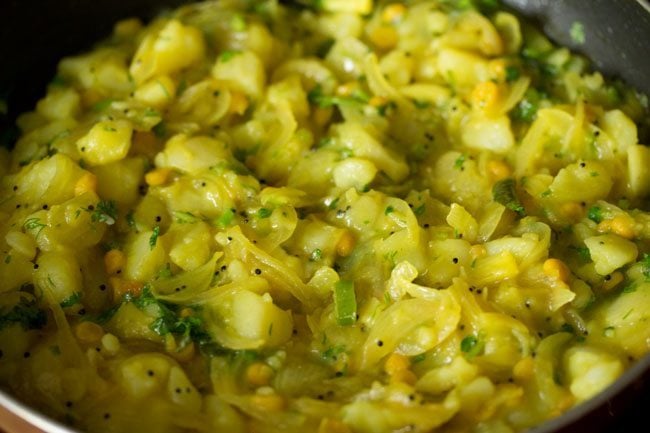
4. Make Masala Dosa
1. Now lightly stir the batter, before you begin to make dosa. You will also see tiny air pockets in the batter with an increase in its volume.
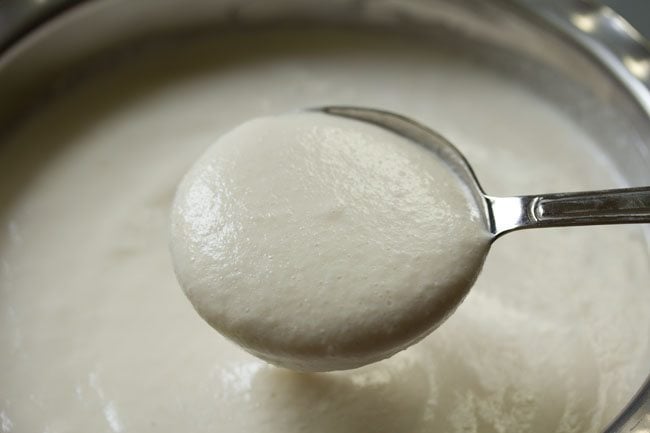
2. Heat a cast iron pan or a flat non-stick pan. The pan should be medium hot. Smear some oil if using an iron pan or griddle. Don’t smear oil on a non stick pan, as then you won’t be able to spread the batter easily.
Dosa batter has a medium-thick to medium flowing consistency and is easily pourable.
Tip 1: If its too thick to spread, add a splash of water and mix it well.
Tip 2: If it has become thin, add some rice flour to thicken it.
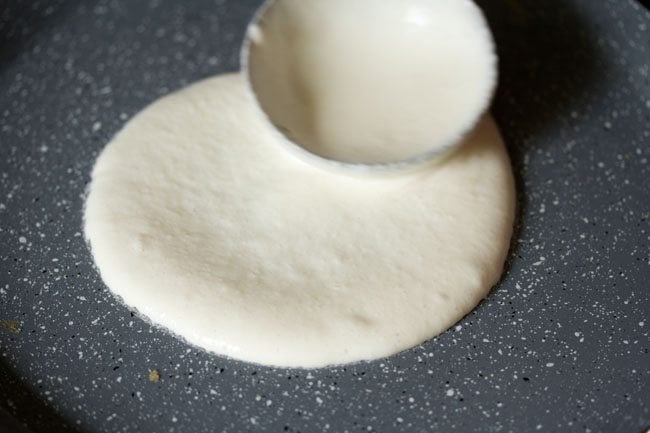
3. Keep the heat to a low, while spreading batter.
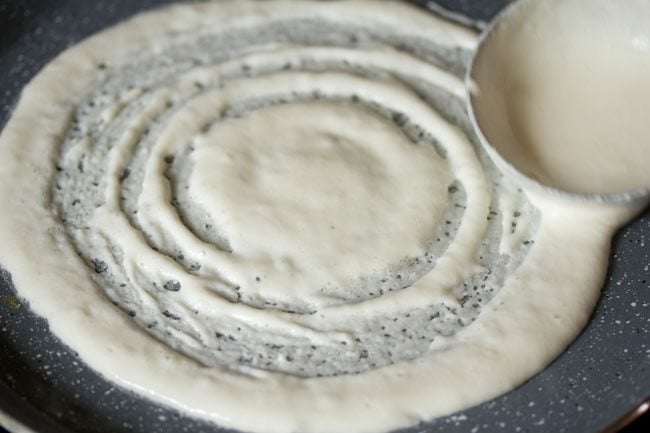
4. Spread the batter in a circular way on the pan. On a medium heat, cook the dosa.
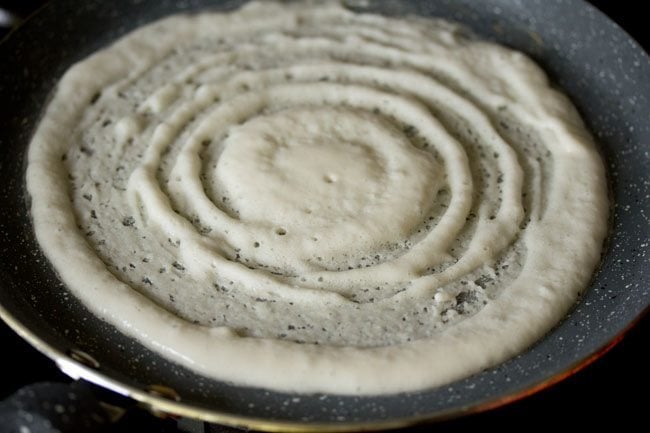
5. Sprinkle some oil on top and edges.
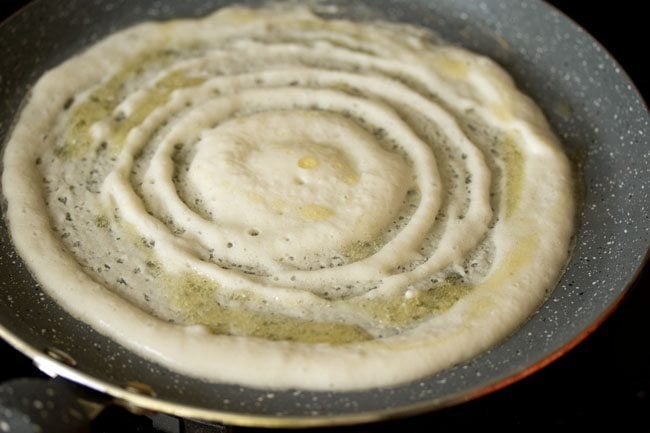
6. Cover the dosa with a lid and let it cook.
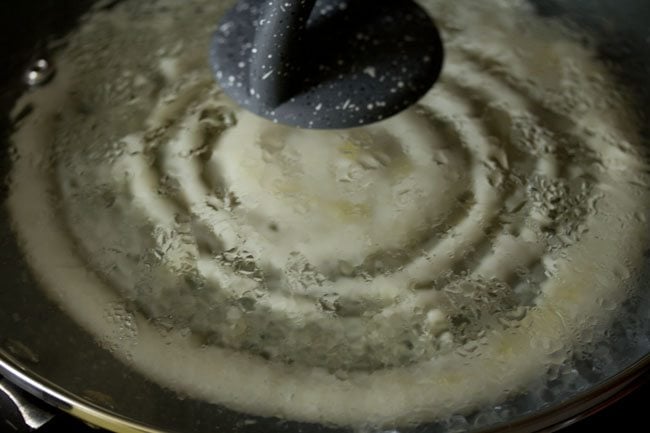
7. Cook till its base becomes golden and crisp. You can spread the oil which was sprinkled earlier on the dosa with a spoon.
You can also opt to flip the dosa and cook the top side.
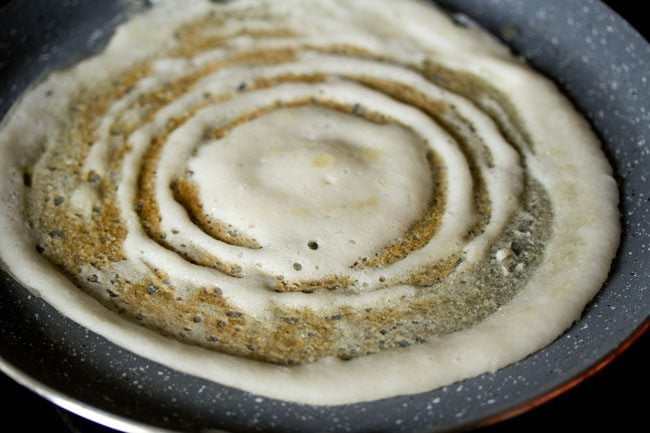
8. When you see the base has become golden, the edges have separated from the pan and the dosa has cooked, place a portion of the potato masala filling on the dosa. You can spread the filling a bit if you want.
If you prefer then you can choose not to place the potato stuffing in the dosa and instead serve it separately. Some people like to have masala dosa served this way. Simply cook the dosa without any added potato filling.
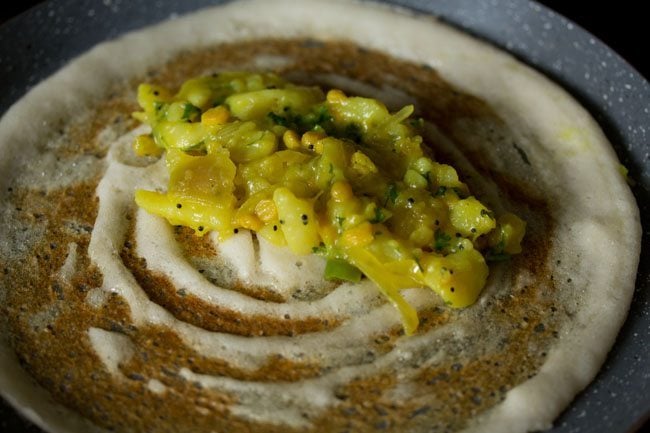
9. Now fold the dosa and serve.
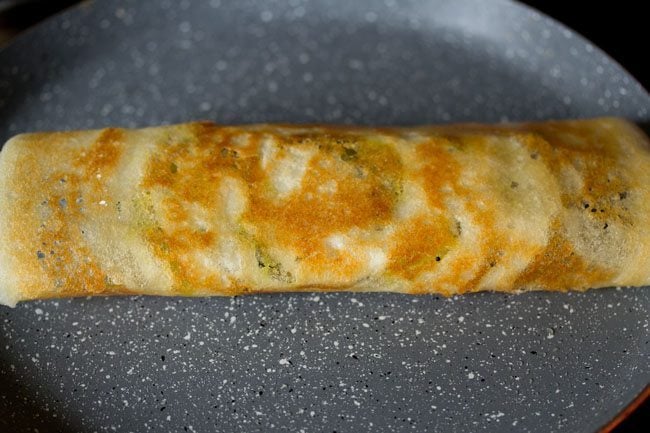
Serving Suggestions
Serve crisp restaurant style masala dosa hot. It’s delicious with sambar and coconut chutney, or your favorite dipping sauces or saucy dishes.
Apart from sambar and coconut chutney, masala dosa also taste good with onion chutney, tomato chutney and peanut chutney.
Storage and Leftovers
The fermented rice and lentil batter stays good for 3 to 4 days in the fridge. You can opt to freeze it for a few weeks too. Store any leftover potato filling in the refrigerator for a day only.
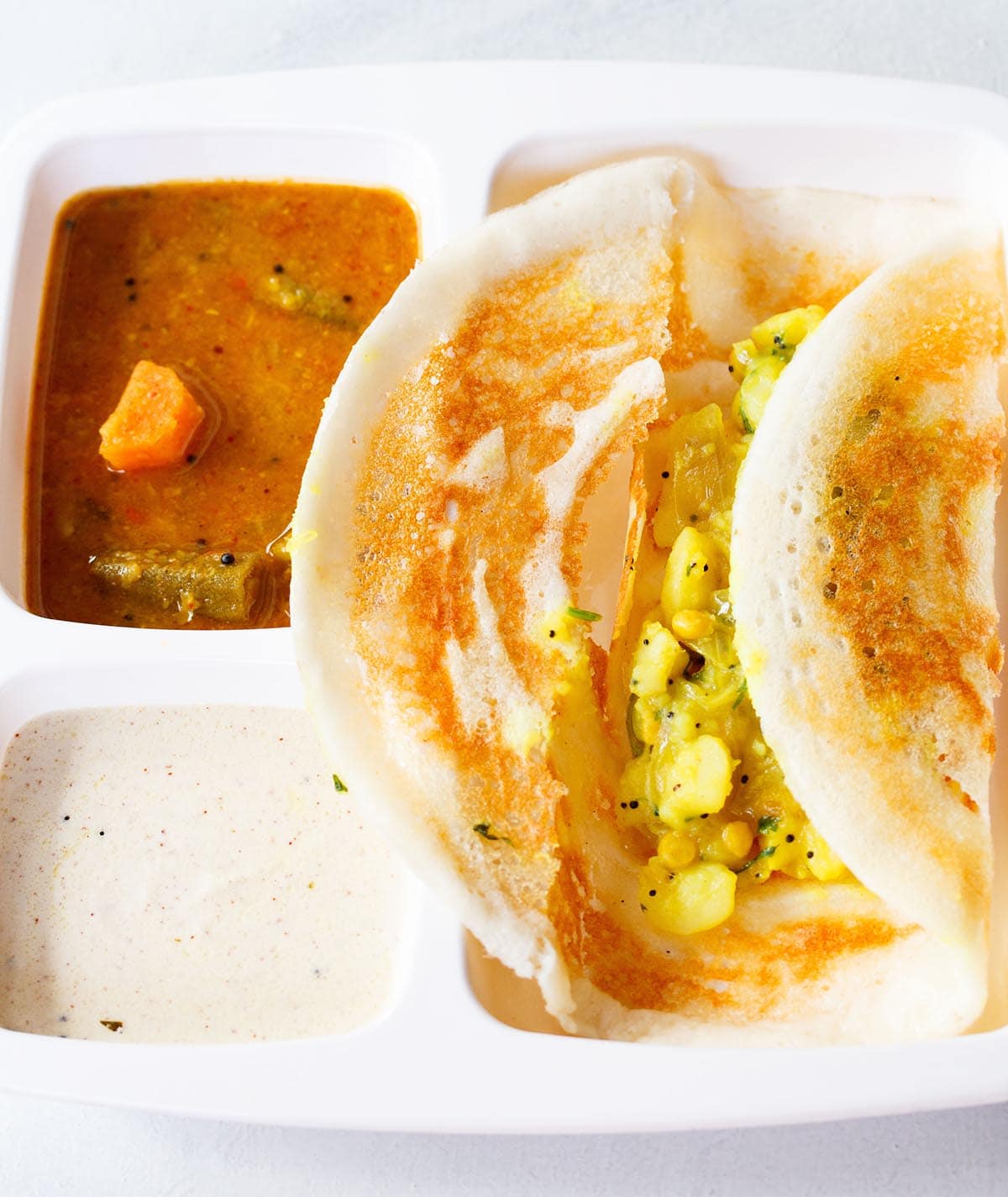
Expert Tips
- Rice: I have used idli rice to make this masala dosa recipe. You can also use parboiled rice or any Indian varieties of short-grained to medium-grained rice, like sona masuri, surti kolam or parmal rice. Many of these rice variants are easily available online.
- Flattened rice and chana dal: Adding thick flattened rice (poha) and chana dal help to make the masala dosa both crisp and soft. It also gives the crepe that lovely golden color. You can skip the poha, chana dal, or both if you like, but if available I highly recommend you use in this masala dosa recipe.
- Fenugreek Seeds: To assist the fermentation process I add fenugreek seeds along with the rice and lentils to make the dosa batter. They also give a nice flavor to the dosa and also help in digestion. Leave out if you don’t have, but again, I suggest you include the seeds if it available.
- Proportion: I find that the ideal proportion for the best dosas is 3:1 of rice to lentils. So to make this hotel style masala dosa recipe, I have used 1.5 cups idli rice with ½ cup of urad dal. I use the same recipe proportions to make Ghee Roast Dosa.
- Fermentation: The rice and lentil batter must be properly fermented for the best masala dosa. You therefore need to store it overnight in a fairly warm place. If you are in a colder climate, keep it in the warmest part of the house and/or increase the fermentation time by some hours or so as needed.
- Cooking Dosa: You need to get the pan hot but not too hot for perfectly golden and crisp dosa. The skillet or nonstick pan should be hot enough to quickly cook and brown the crepe, but not so hot that the batter immediately sticks and cannot be spread evenly.
If using a cast iron pan, sprinkle with water and wipe clean between cooking each dosa to keep the heat just right. For nonstick pans and skillets, first get the pan to become hot, then reduce the heat to low and spread on the batter. Increase the heat back to medium and continue to cook the dosa. - Make ahead: The lentil and rice dosa batter can be made ahead and kept in the fridge, but should be used within 3 to 4 days after fermenting.
More Tasty Dosa Recipes
Breakfast Recipes
Karnataka Recipes
Breakfast Recipes
Breakfast Recipes
If you’ve tried this recipe, please rate it in the recipe card or leave a comment below – I’d love to hear your feedback. For more vegetarian inspiration, sign up for my email updates or follow me on Instagram, Youtube, Facebook, Pinterest or X.
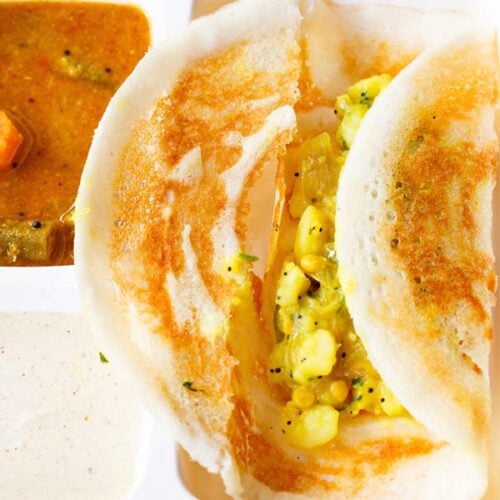
Masala Dosa Recipe (Hotel Style)
Ingredients
Ingredients for batter
- 1.5 cups idli rice – 330 grams, (parboiled rice, ukda chawal, sela chawal) or 1.5 cups regular rice
- ½ cup urad dal – 125 grams, husked whole or split black gram
- ¼ cup thick poha – 35 grams, flattened rice
- 1 tablespoon chana dal – husked and split bengal gram
- 20 fenugreek seeds (methi seeds)
- 1 cup water for soaking urad dal
- 2 cups water for soaking rice
- 1 cup water for grinding rice & poha
- ½ cup water for grinding dal
- ½ teaspoon rock salt (edible and food grade), add as required or sea salt or pink salt
Ingredients for potato filling
- 4 potatoes medium-sized potatoes – 300 grams or 2 cups boiled, chopped or crumbled potatoes
- 2 tablespoons oil – any neutral oil
- ½ teaspoon mustard seeds
- 1 tablespoon chana dal (husked and split bengal gram) soaked in ¼ cup hot water for 30 minutes – optional
- 1.25 cups onions thinly sliced, or 2 medium to large – 150 grams
- 1 teaspoon ginger – finely chopped, or 1 inch peeled ginger
- 8 to 10 curry leaves
- 1 teaspoon green chillies – chopped, or 1 to 2 green chillies
- ¼ teaspoon turmeric powder
- 1 pinch asafoetida (hing) – optional
- ½ cup water
- 3 tablespoons coriander leaves – chopped
- 2 tablespoons cashews – optional
- ¼ to ½ teaspoon sugar – optional
- salt as required
Instructions
Soaking rice and lentils
- First take all the ingredients in bowls. Take rice and flattened rice in separate bowls. Take the urad dal, chana dal and fenugreek seeds in one bowl.
- Rinse the urad dal, chana dal and fenugreek seeds a couple of times. Then soak them in 1 cup water for 4 to 5 hours.
- Rinse the rice a couple of times and keep aside.
- Rinse flattened rice once or twice and then add to the rice.
- Pour 2 cups water. Stir and soak both rice and flattened rice together for 4 to 5 hours.
Making batter
- Before grinding, strain the water from the soaked lentils and keep it for grinding urad dal.
- Add the lentils in the grinder jar. Also add ½ cup of the soaked and strained water to the dal. You can even use fresh water while grinding.
- Grind the urad dal, chana dal and fenugreek seeds till you get a batter which is light and fluffy. The urad dal has to be ground really well, so that the batter ferments well.
- Remove the batter in a bowl or pan with a spatula.
- Strain the rice well. Then in the same grinder, add the soaked rice and 1 cup fresh water. You can grind rice in one batch or in two to three batches. This will depend on the size of the grinder jar. To make the batter, I added 1 cup water. You can even add ¾ cup water while grinding. Addition of water will depend on the quality of rice.
- Grind the rice till you get a fine grainy consistency in it. The rice batter should have a fine rava (cream of wheat) like consistency. You can even grind to a smooth batter.
- Now pour the batter in the same pan or bowl containing the urad dal batter.
- Add ½ teaspoon edible rock salt or add as per taste. You can also use sea salt or pink salt.
- Mix the salt very well with the batter. Also mix both the batters very well. Cover and keep aside to ferment for 8 to 9 hours. You can keep batter to ferment for less or more time and this will depend on the temperature conditions in your city.
Preparation for potato filling
- First rinse and then boil 4 medium sized potatoes in 2 cups water for 5 to 6 whistles in a pressure cooker. You can also boil potatoes in a pan or in an Instant pot. The potatoes have to be completely cooked and fork tender.
- When the potaoes are cooking, soak the chana dal in hot water for 30 minutes. Then drain the chana dal and keep aside.
- When the pressure settles down on its own in the cooker, remove the lid. Drain the water from the potatoes and let them become warm. Then peel and chop them.
- Also slice the onions thinly and chop the green chilies, ginger and coriander leaves.
Making potato filling
- Heat oil or ghee in a frying pan or a skillet. Fry cashews and keep aside. This step of frying cashews is optional.
- Lower the flame and add mustard seeds and let them splutter. Then add the chana dal.
- Saute the chana dal for 2 to 3 minutes on a low flame or till they turn light golden or golden. Now add the sliced onions, curry leaves, green chilies and ginger.
- Saute the onions stirring often till they soften and turn translucent.
- Add the turmeric powder and asafoetida (hing). Mix very well.
- Add water. Mix well and simmer for 2 to 3 minutes or till the mixture thickens a bit.
- Next add the boiled chopped potatoes and mix very well. You can also mash the potatoes if you like while cooking them.
- Season with salt according to taste. Also add ¼ teaspoon sugar for a slight sweet taste.
- Simmer on a low flame for 3 to 4 minutes stirring occasionally. The water will reduce and the consistency will thicken.
- Switch off the flame and then add chopped coriander leaves. Also add the fried cashews now and mix well. The potato filling should be moist and easily spreadable on the dosa. Make sure there is no water in the potato filling. It should not be of a curry or gravy consistency.
- Stir and keep the potato filling aside.
Making masala dosa
- Lightly stir the batter, before you begin to make dosa. You will also see tiny air pockets in the batter and it would have increased in volume.
- Heat a cast iron pan or a flat non-stick pan. The pan should be medium hot. Smear some oil if using an iron pan or griddle. Don't smear oil on a non stick pan, as then you won't be able to spread the batter.
- Keep the flame to a low, while spreading batter.
- Spread the batter in a circular way on the pan.
- On a medium flame, cook the dosa.
- Sprinkle some oil on top and edges.
- Cover with a lid and let it cook. You can spread the oil which was sprinkled earlier on the dosa with a spoon. Cook till its base becomes golden and crisp.
- When you see the base has become golden and the edges separate from the pan, place a portion of the potato filling on the dosa. You can spread it a bit if you want.
- Now fold the dosa and serve.
Serving Suggestions
- Serve crisp restaurant style masala dosa hot with coconut chutney and sambar.
- Alternatively, simply make the dosa and serve the potato filling separately in a bowl.
- You can also choose to serve masala dosa with onion chutney, tomato chutney or peanut chutney.
Storage and Leftovers
- The batter stays good for 3 to 4 days in the fridge. You can opt to freeze the batter for a few weeks too. Store any leftover potato filling in the refrigerator for a day only.
Notes
- You can use regular variety of short grained to medium grained rice like sona masuri or parmal rice.
- The batter should be well fermented. It should have a pleasant sour aroma and should increase in volume after fermentation. In a well fermented batter you will see many tiny air pockets. Ensure that you don’t over ferment the batter as this will result in a very sour tasting dosa.
- If using a cast iron pan, make sure it is well seasoned or else the dosa can stick on it.
- According to me the ideal proportion for the best dosa is 3:1 ratio of rice to lentils. However feel free to change and add some more lentils for a protein boost.
- The fermentation depends on the temperature and climate in your city. In a cooler or colder climate the fermentation will take more than a day. To quicken it, I suggest to keep the batter in a warm place or use the yogurt settings of your Instant pot to ferment the batter.
Nutrition Info (Approximate Values)
Masala Dosa recipe from the archives was first published on January 2010.
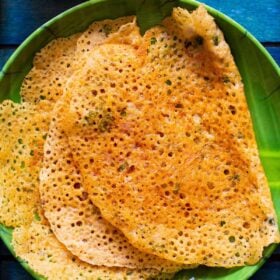
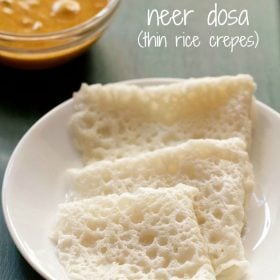
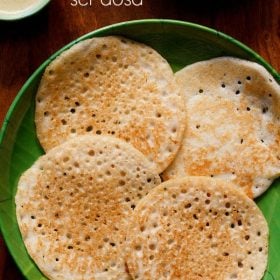
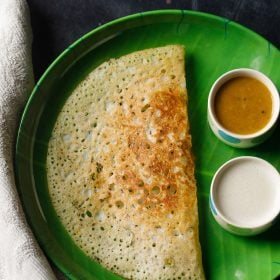
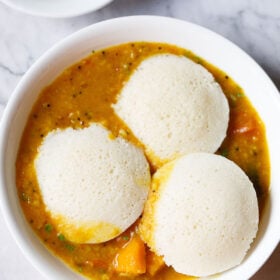
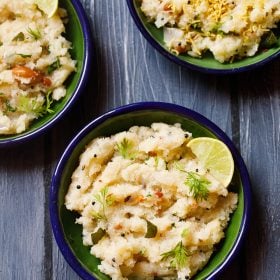
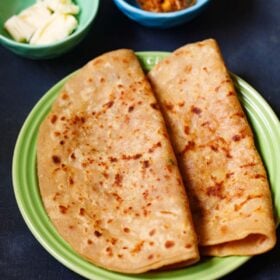
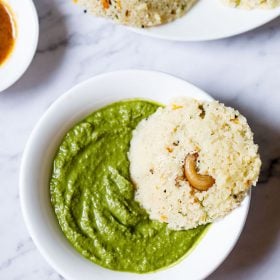








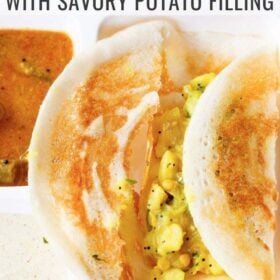
It is yummy and relishing dosa.
Since the time I’ve tried this recipe of masala dosa, I’ve literally forgotten the ones at restaurants or any street side as well. The yummiest recipe ever!
Thanks a lot and glad you liked the recipe.
Thank you for the recipe. There is also a red paste that is spread over the dosa while it is being prepared, just before the aloo is added.
Will it be possible for you to experiment with that and update that on this recipe? Thanks again.
I have shared the recipe on a separate post. Here it is Red Chutney.
You could opt to slightly sauté the onions and garlic lightly in a bit of oil, if you prefer, while making this chutney.
Thank you very much.
When you try and change the amount of your recipe, the number of cups change but the grams dont change- please correct. Otherwise I love your recipes.
Thank you. I know about this and I am updating it slowly in all the posts.
Hi thank you for your amazing content!
Just wondering how come restaurants dosas always have a slightly sweeter taste to them as compared to the ones we make at home ? Do you add sugar to your batter?
I generally don’t add sugar but in some restaurants they do add.
my favoriteee
this looks totally delicious, will try to make it soon! thanks for the detailed explanation
Thanks for sharing your recipe
Welcome.
The potato filling turned out perfect! One of the best dosa recipes i have found online. Thanks you for sharing:)
Great and thanks for the super feedback on the recipe. Most welcome and happy cooking!
Can I use besan instead of chana dal??
yes, you can use besan.
Dasanna, thanks for your comments on the structure of the dosa. My batter is not that dilute. In any case, I will add a bit of rice flour and try again. Hope it will work. Keep up the great work you are doing. Regards, Rom
welcome rom and do let me know how the rice flour tip turns for you. thank you.
Hello Dasanna, I followed your recipe for making dosa as well as masala curry to the last letter. Both came out excellent. However, I am disappointed about one aspect. When I spread the batter on the cast iron skillet, immediately I noticed millions of holes on the surface of the dosa like you get on rava dosa. I did not get the smooth outer surface you notice on the dosas made at the south Indian restaurants. I am wondering what is happening with the batter I made. I would appreciate if you have any thoughts on this. It is not a major complaint, but I am a perfectionist and would like to replicate closest to the restaurant made dosa. Thanks in advance.
thank you rom. i guess this is happening due to more water in the batter. a thick pouring batter will give you the restaurant style dosa. so you can reduce the amount of water added while grinding. i have made dosas with thin batter and they do have limp texture with many holes in it. there would be less crispness or no crispness in them. it is good if someone wants soft thin dosas. but for a crisp dosa, it is better to make a thick batter but one with a pouring consistency, so that the batter can be spread easily in the pan.
you can also try adding some rice flour to the batter and make dosa. i usually do this when accidentally i have added more water while grinding or the quality of lentils or rice required less water than the usual. add rice flour and mix the batter very well. the batter will thicken. hope these suggestions help.
Hello Madam,
I have been following your superb guide and recepie for over 6 years now and whatever I make according to your easy Instructions comes out spot on you are a asset and have a huge following and I thank you..Just wanted to know I was using your guide through Veg Recipes Of India App, the but unfortunately I cannot find that app anymore, Also Madam when are you launching your YouTube channel, the i can tell you for sure in a short span you will have not hundred of thousand but millions of subscribers…Always Warm Regards
thank you karan for this feedback. glad to read. we had an app, but due to a lot of user complaints we had to remove it. there were a lot of technical errors users would get based on the phone type, model and brand. the company who had made the app was not very helpful and we could not alone manage these technical issues.
we have a youtube a channel but i am not adding any videos after 2017. creating videos has taken a backseat but now i am looking at ways through which i can easily shoot and edit videos in a considerably less time and effort.
thanks for your best wishes and kind words.
Dear Madam,
I cannot thank you enough for all the lovely recipes you have posted.
This site is like a second mother to all the daughters who very much need their Mother’s for assistance, whilst cooking!
Also appreciate the fact that, it takes a lot of time and efforts to post the step by step methods with all the pictures.
Thank you again. I keep trying your recipes and it turns out really well. Thank you and God bless you! :-*
hi divya, felt so good to read your comment. thank you very much. yes it does take time and effort to share recipes with step by step post. thanks for understanding this. most welcome and i wish you all the best.
This is my go to recipe for making masala dosa every Sunday for breakfast for over a year now. The proportions given in the recipe are perfect and ensure a perfect crispy dosa – never fails. Many thanks Dassana for a superb recipe.
welcome Jennifer. Glad to know this.
Hi Mam,
I have tried most of your recipes and each one of them has come out picture perfect . And it’s yummylisious????. Thank you so much for your perfection in penning down the recipe which is very hard to find ????.
so glad to read your comments safra. thanks for these words. it does make me feel good when the recipes turn out good. thanks again and happy cooking.
Masala dosa was my favorite when I was in India!
I am so grateful finding you and your wonderful recipe ????
I would like to ask, is 20 seeds of fenugreek 1 teaspoon of fenugreek powder, more or less?
Thank you for your time and your tasty recipe!
thanks katerina. glad.
20 seeds of fenugreek will yield approx 1/8th to 1/4th teaspoon fenugreek powder depending on the size of the fenugreek seeds.
Awesome masala dosa recipe,I prepared everybody praised me, thank you so much. Please post bhendi sabji recipe
thanks manisha for this awesome feedback. so glad. i have shared many bhendi recipes.
Can I use fenugreek power in stead of seed?
you can use fenugreek powder. but grind it along with the urad dal.
Hi..
Tried your masala dosa recipe…must say it came out really well..I love to cook and try new. And I ve tried even few of your other recipes.. Your instructions are really simple to understand and it shows your effort and dedication before sharing them.. Thanks a bunch from me and my family..
Welcome Jenevia. Thanks for sharing your positive feedback on masala dosa recipe. Glad to know that you like the recipes presentation. Do try some more recipes.
Hi
Good recipe
But can you please elaborate how to cook dosa on iron tawa….as my does always sticks on it!
you need to season the iron tawa. for seasining, heat the tawa and spread some oil on it and heat it for a minute. then wipe this oil and spread second layer of oil. you can do this step one or twice more if you want. then for the last spread of oil, switch off the flame and keep the tawa with the oil coating for a couple of days or a week before you use it. then heat the tawa, wipe the oil. spread another layer of oil. wipe this too and then start making dosas. also do note that use this tawa for making only dosa or for shallow frying. do not make rotis on this tawa. for rotis you can use a separate tawa.
Thanks Dassana !! I will go for the smaller one. 🙂
welcome shilpa.
For the First time I fell in love with Dosa????????…. Thank you sooooooo much for this recipe????
thats nice to know. thanks a lot for sharing this.
Thanks Dassana, you always reply to the queries. love you for this and I really appreciate your efforts. I became a big fan of you. I was confused between rock and lodge as there are so many good reviews about lodge but is very expensive. I think I should go for rock.
welcome shilpa. yes lodge is expensive. rock is also good. i have read the reviews also. just buy the one which is smaller in size. i had purchased one for my mom and it was too large. but the tawa was very good, just that my mom was finding it difficult to lift it as its very heavy,
Hi Dassana
I have some questions if you can help:
1. I want to use regular rice. So what wI’ll be the proportion of rice to urad daal for ‘crispier’ and ‘brown’ dosa?
2. Can you please suggest some good cast iron tawa for making dosa available online?
Or should I buy it from the local market?
3. I want to buy cast iron kadhai also. So I want to ask is it good for everyday cooking? ( From health point of view?
Thanks in advance. 🙂
shilpa, your queries answered below:
1. you can add some more urad dal. you can either use this recipe proportion for regular rice or use half cup of urad dal for 1 to 1.25 cups of rice. but when the proportion of urad dal is more, you will get more of its taste in the dosa. if its fine with you, then you can use the above proportion.
2. you can use zishta or rock brand available on amazon.in. you can also use lodge brand, but it will be expensive compared to indian brands. i have zishta iron kadais and dosa tawa. the dosa tawa is concave shaped but i have made dosas in it and they are good. buy the smaller size as even that one is too big. do note that these cast iron pans are very heavy to lift. you can also buy from local market. i have one cast iron pan purchased locally and it works very well for making dosa. i also have a lodge pan and even that is good.
3. i have a set of 3 cast iron kadais from zishta brand. they are good. i use them for deep frying as well as making veggie dishes. but do note that if the recipe has too much of acidic ingredients like tomatoes or curd, then better to use a steel pan and not make them in iron pans.
Hi
As for the batter consistency after ferment – in your pic it looks like the “liquid level” is high. But in my batter after long hours of ferment – it’s not so liquid. Should I add water ? When – after grinding or after ferment ?
Thank!
noam, of course you can add water after fermentation. for dosa, the batter is usually of medium consistency. i also add water after fermentation if the batter looks thick. the batter has to be easily spreadable on the pan, so you can add water accordingly.
Hi Dassana, I am a fan of yours. I tried many south recipes from your website and all were good. Nariyal laddu were awesome. Dassana I have tried your dosa recipe too and it also turned out great. Please tell me can we make dosa on marble Stone as patthar kabab or patthar gosht is made? Please reply soon.
Thanks Vibha for your kind words. I never tried but i think it should work. Because marble surface is smooth.
hi again
I tried the recipe and its really good! can u please give us tips about how to make the dosa even more crispy?
thanks!
Thanks Noam. try to spread the batter thinly. tawa should be hot but not very hot. once you spread the batter on tawa then increase the flame. cooking dosa for some more time will make it crisp.
thanks for the detailed info!
Welcome Noam
Hi
What other chutney then coconut do u recomand to serve with the dosa ?
noam, apart from coconut chutney, you can use onion chutney, tomato chutney, onion-tomato chutney and peanut chutney. all recipes are already posted on website.
Hi and thanks for the detailed recipe.
I wanted to know in which percent should the batter become bigger after the fermentation ? should the butter become double ? add only 50% etc.
thanks.
batter becomes doubled or tripled. if it gets more fermented, it will be triple or even increase more in volume. the signs of proper fermentation should be that the batter will be doubled, it will have tiny air bubbles and will have a pleasant sour aroma.
Thanks dassana. .my family loved the masala dosa..and best my 4 years old daughter loved it ..thank you so much
Welcome Swati. Glad to know this.
Hi Dassana , Thanks for the recipe, Gr8 outcome , To get 5 dosas what should be the size?I assume this recipe makes 1ltr of batter ? thanks in advance
i did not get your query. what should be the size of what?
Hi,
I have always observed that my batter for idli/ dosa does not ferment well. The problem is, batter has the sourness next day but it does not raise upi.e the next moening.The quantity is same but no fluffiness of the batter is there.w hat could be reason for this?
lija, firstly grind the urad dal batter really well. it should have a soft fluffy like consistency. also try adding some water to the idli batter. i hope this solves the problem you are facing.
hi
should I stir it while the fragment is done?
thanks.
welcome noam. you can stir, once the fermentation is done. but stir it lightly.
hi
after grinding the rice, it’s still grainy, i thought it will be more cream – is it ok?
is the salt help the fragment process?
Noam, the rice can be a fine grainy consistency. in cold region, avoid salt. in warm places add salt so that the batter is not over fermented. it slows down the fermentation.
Hi Dassana
This recipe of yours did wonders for me.
I have tried dosa once before and I was so unsatisfied with the result.
But this recipe is a big hit with my hubby who is great fan of South Indian cuisine. And he said, he never had a dosa as amazing as this one.
I followed the coconut chutney recipe too from your blog and it again tastsd amazing.
Thanx a ton for your recipes.
Looking forward for more, specially Chat Masala recipe, of you can include in your blog.
Thanx a lot again ?
Welcome Bharti. Glad to know this. Thanks for sharing positive feedback on dosa and chutney. I will try to add chaat masala recipe soon.
hi
can I soak for wholw night and not only 4-5 hours ?
thanks.
welcome noam. soak only for 4-5 hours. otherwise it will start smelling.
Made dosa for first time ever..and that too for my in-laws ..thnk u so so so much for this recipe..it came out great!!!!…pics helped the most!
Welcome Prabha. Glad to know this.
Can I skip the asafoetida in the potato mixture?
Dimpi, yes you can.
Which mixer grinder are you using? I am living in US and I am planning to buy a mixer grinder to make dosa and chutney. Which grinder do you suggest?
archana, i am using preethi mixer grinder (blue leaf brand, 750 watts) with 4 jars (2 wet & dry grinders, 1 spice & chutney grinder and 1 juicer). till now this mixie has been working for a long time as compared to the other mixer grinders which worked only for some months. i use the mixer-grinder regularly.
Great recipe
Looks perfect..may I know wat tawa do u use for making it.is the non stick one safe?
thanks. non stick is safe provided you don’t scratch the non stick surface with steel spoons or spatula and also do not use the pan on a high flame. for dosas i use two pans, one is this one which you see in the pics and the other is a cast iron pan. this one is a granite look non stick pan from wonderchef.
nice
Hi Dassanaji, have tried posting my comments few times but somehow I think it doesn’t get posted. Hope this one does ?. First of all thank you very much for providing such great and simple to understand recipes. I have made dosa with your recipe number of times but every time the crispness is different. I need super crisp dosa that’s how my husband likes it. What can be done for that? I use basmati 1 cup and sona masoori 1 cup and rest similar to your ingredients. Please help.
Thank you
Shraddha?
shraddha, i have only received one comment from you and its in the bombay pav post. i do check the spam folders, but your comments are not there. for a super crisp dosa, you can add chana dal and some poha. a pinch of sugar also helps. i have posted a recipe of ghee roast dosa, that really gives crisp dosa. while making dosa, do keep the flame on a low or sim, so that you can spread the batter thinly. when the dosa is cooked from top, then spread oil or ghee all over the dosa. this also helps in crispiness of the dosa.
while I’m searching for any recipe…. by mistake one word wrongly typed… then it shows nothing found… and app is slow… while I’m using fast internet… other than this…. your recipes are awesome…. and I learn lots of recipes from you….
thanks for letting me know shalini. the app search is based on the website search. so if anything is wrongly typed or the search word is not there in any of the posts, then there will be no results. for app being slow, i will check. thanks again.
excellent recipes with pictures…..plzz try to improve mobile app also…..
thanks shalini. are you having any issues with the mobile app. let me know.
Yummy!!
Nice n simple. I like the way photos are given along with description
glad to know this thank you jas 🙂
Thanks for helping
welcome divyanshi 🙂
Today I tried Dosa sambhar, n it was my first attempt for Dosa… But your recipe made it PERFECT……thank you
thankyou prabha 🙂
I love dosa and would love to make this. Is it possible to make it without a wet grinder?
christine, you will need a mixer-grinder or a table-top grinder to make batter. if you have a blender, than the blender has to be a sturdy one and with high speed. i have seen some people using vitamix blender.
What is poha and parboiled rice??
sakchi, poha is flattened rice. parboiled rice is rice which has been partially cooked and then husked and pounded. you will get them easily in grocery stores or super markets.
I just recieved a wet grinder and am new to making dosa. Would thick or thin poha be preferable? This recipe looks delicious I can’t wait to try it! Thanks!
you can use either thick or thin poha. but generally i use thick poha.
Thank you!
welcome michele.
After the batter is fermented,do I keep in the refrigerator.?for how long?
shanie you don’t add salt to the batter, place in the fridge should last for a week.
good and so tasty
when I make dosa, it starts to leave from the corner automatically before getting cooked. Why does this happen??
if this happens sneha just flip and allow until they are cooked. may be the batter is too thick or the pan is too hot. hope this help’s you.
Thanks so much for the masala dosa recipe!
Worked out great in my very first attempt. I was expecting to take a couple of tries before getting it right… 🙂
But I must say all your recipes that I have tried have always worked great for me.
Thanks again!
thank you laila. glad to know the masala dosa recipe worked well for you. also thanks for the feedback on other recipes.
What is parboiled rice? What else can i use instead of dat? I think i wont find it here in australia
parboiled rice is rice that is partially cooked, then husked and dried. you can use regular rice. just use overall 2 cups of regular rice.
Description of making a receipe is nice nd easy to do….good going……I tried masala dosa nd carrot halwa it comes out well
glad to know this eawari thankyou for trying both the halwas 🙂
Hiii… Please tell me that do we have to cover the lid while leaving rice and urad dal paste for fermentation or not?
the bowl or pan has to be covered with a lid while keeping the batter for fermentation.
I love your site! Thanks for making Indian cooking accessible to others. Question: When you make your dosas, do you use a nonstick pan? The pictures above look like nonstick. If so, do you have a brand that you like? Thanks a lot!
thanks CJ. the one used in this post is a non stick pan. its an international brand and i do not remember the name now. this was from a set and belonged to the owner of the house, which we had rented around this time and i do not have these pans now.
Hi,
First, many thanks for all the recipes on this website.
I like dosas, but, unfortunately, where I live right now urad dal is not available. Can I use some other dal instead, and get similar results? Will moong dal and masoor dal ferment like urad?
thankyou so much milosh 🙂 yes you could use moong dal instead of urad dal in the same proportion as given in the recipe. yes moong dal ferments and is more healthier but yes the taste would differ. however both dosas made with urad or moong dal taste good surely try and let us know.
OK, thank you, will try it 🙂
welcome milosh
Thank you so much!!!! I read the whole thing. Seems very promising. I am going to try it soon. Thank you for sharing. Do you have a sambar recipe as well? Can you please share.
i have already shared many sambar recipes. using the search icon you can search them on the blog.
Hello Dassana,
Thank you for the dosa/idli batter recipe. I did try out. I dint add the piha though. I released that the idlys were hard and the disas were very crispy and hard like pappads. Was it because of poha alone? Or should have ground the batter more?
Nikhila
hi nikhila, looks like the batter did not ferment well. when the batter does not ferment well, then the idlis turn out hard. addition of poha does help in making the idlis more soft, but if you don’t add then also it fine. fermentation is one of the most important aspects of an idli or dosa batter and it depends on conditions like temperature, humidity, age and quality of urad dal and rice, water content in the batter etc. i am not sure what exactly has contributed to the batter not fermenting well. the batter should double or triple after fermenting. the batter also needs to be ground well.
I wanna knw how vl i cme to knw abt the consistency of batter as the recipe z ol abt batter. How much water to b added while makng batter.
for dosa the batter has to be a bit thin than idli batter. difficult to tell the amount of water as it depends on the quality of rice, urad dal and the type of grinder used. the consistency has to be pouring but slightly on the thicker side. hope this helps.
I really love your recipes… I have tried Hyderabadi paneer and kadhai paneer recipes
. n they taste awesome.. Thank u so much..for so simple and helpful recipes…:*
welcome surabhi. glad to know this.
Hi Amit, thank you for the recipe, you always make everything too simple to understand. I came to know about your site when I was searching the recipe of instant coffee. The way you explain the recipes along with pictures is a unique approach. I don’t even want to visit any other site after I get to know about yours.
The things which I like about your blog is:
1- First of all you give a nice introduction of the dish, after which you explain everything step by step very clearly. And at the end you give the whole recipe in a nutshell.
2- Your approach of explaining the recipes that is with PICTURES. I am in love with this.
3- Everything is given in layman’s language.
4- You reply to most of the comments which means you read them and efforts of the readers (those who write the comments) are not in vain.
Thank you so much and Good Luck 🙂
thanks a lot gauri for your encouraging comment and taking the time to write in points. genuine appreciation from my side. thanks once again.
Welcome 🙂
I made this at home and it was an instant hit…. Also the green chutney sandwich with coriander leaves…. My dad even called it five-star like 🙂 ….. ( this was the first time my parents ate a sandwich made out of coriander leaves) …… It made my day …. Thank you …. 🙂
welcome anju. glad to know this. thanks for sharing positive feedback.
Hi,
Please let me know if par boiled rice can b substituted ?
Thanks
sim
welcome sim. yes you can.
really nice understanding of dosa thanks
welcome jalpa
excellent recipe
Yours website is really good iam enjoying cooking…thanku so much
welcome pooja
Hi Dassana,
Can u please post khichda recipe, and not khichdiii.
gehu ka kuta hua khichda banate hai alag alag caste ke log like muslim and others too. I want you to post it….
hi nishu, i know about khichda. in fact i have tasted it also a couple of times. have added your request in the recipe request doc.
Thank u so much…… and the batter was fermented, but very late, around 11 or so… will be eagerly waiting for the khichda recipe….
welcome nishu.
Hi Amit,
I too simply love ur site. Each time I see get so excited that I think of making all the dishes in one single day.
I want to ask one query.I did all that was mentioned above for making batter, but the batter didn’t rise no were near like urs did. I guess it did not even rise or got fermented. What could hav3 been the reason.
And also I was unable to grind the rice batter to a very thin paste, despite grinding the batter for 3 times.It still had little touch of very small granules feel.
plz help.
the fermentation or doubling, tripling of the batter depends on the temperature. a warm temperature is always good. do you live in a cold climate or is it cold season where you live. if yes then its due to the cold temperature. i always preheat the oven at a very low temperature for 15 to 20 minutes. switch off and then keep the batter in the oven. you can also wrap the batter in a warm towel and keep near a warm place. fine rice granules in the batter are fine. it need not be a paste.
Hey Buddy !!
Well I guess u r keeping gud. I must tell you that I m your really big fan, actually I am ca student and whenever I get bored and exhausted I try out your recepies and its quiet relaxing. Its lyk I want ur autograph …… Your recepies are amazziiinnnngggggg ……. These exotic recepies really are marvellous.. I’ve tried quiet many .. A grand salute to u for being so diversingly talented. Hope I cud meet u some day!!
Lots of affection and wishes 4 u…. GUD DAY!!
Byyeee…….
thanks a lot sugandha for this sweet and encouraging feedback. i don’t know what to say but i am touched and humbled.
Hey dassana
your recipes are really wonderful
I have cooked many food items followed by your recipes.
thanks a lot.
welcome rizwana. thanks for sharing positive feedback on recipes.
I love to see all ur dishes turning out extremely well. I need some more variations and new recipes for breakfast.
thanks jayashree for sharing positive review on recipes. check more breakfast recipes at this link – https://www.vegrecipesofindia.com/recipes/indian-breakfast-recipes/
Hi Dassana
I just love your recipes,they always turn out perfect!
I really want to make dosa but i can´t get urad dal where i live,can i replace urad dal with anything else? another lentil? grain? bean?
thanks!!
welcome paul. one of the essential ingredient of south indian masala dosa is urad dal. there are other version of dosa also like only made with rice or rice flour. i don’t have any dosa version recipe made only with rice. but you can check this onion rava dosa which i have already shared on the blog.
Hi, I tried this recipe today in not so sunny England and fermented the dough overnight in the oven. It came out perfect and was easy to spread and had nice crispy dosas, I made your coconut chutney as an accompaniment and it was amazing, I will definitely make them again! Thanks!
welcome anu. thats good to hear. thanks for sharing positive feedback on recipes. do try some more recipes.
Nice One. Tried It Out !!! Worked.
thanks suchitra for sharing this positive feedback.
I’m making some batter right now. My blender couldn’t get the rice batter totally smooth – so I passed it through a sieve. It’s looking promising, now just to see if I can get the fermentation going in an English winter….(I’ve left it in a warm spot)….
if there the batter is a bit grainy, its fine. its difficult yo grind rice in a blender. i would suggest to keep the batter in a warm oven (oven which has been preheated before and then switched off) or lighted oven or near a heater wrapped with some warm clothing like a shawl.
Really nicely explained and loved your recipe and plus point of the screen shots . Kudos ! Keeping doing the good work.
thanks gunjan for sharing positive feedback. glad to know that you liked the recipe presentation.
Hai, this is the first time I am viewing for site. It is very easy to understand the steps and the photos of the recipes are also making us to get things more easier. Good luck.
thanks vasumthra for your positive feedback and best wishes. do try some recipes.
Hi,
the batter was perfect. But I tried on the tawa, it was sticky and not thin like rice paper, I could not proceed. I have freezed the batter, waiting for your advice.
thanks
welcome venu. probably the batter has become thin. thats why it is not like rice paper. just add some rice flour to the batter to thicken it.
Hey Dassna, as a first-timer i had issues in fermentation of batter. After waiting for 3days i added 1/2 teaspoon baking soda and 1/4 teaspoon yeast. It worked! I skipped poha rice as i couldnt find that in Islamabad. And also missed fenugreek seeds. But still your recipe did wonders 🙂 many thanks for sharing!
welcome sadia. both yeast and baking soda work. thanks for sharing your experience.
Hi Dassana:
Fantastic blog site with fabulous recipes. I tried several different recipes and various ingredients for making the dosa. Each time the dosa comes out very good but still I am not able to replicate the taste of the dosa that is made in Udipi and other South Indian restaurants. I am wondering what is their secret? Do you know what ‘tricks’ they use to get that taste in the restaurants? (I hope it is not patented!)
Do you know how to make ‘Chakrapongali’ (I am sure there are many variations of this spelling)? A very popular sweet dish made with rice/moongdal/jaggery in Andhra and Tamil Nadu. Please post the recipe, if you know.
Thanks very much,
Rom
thanks rom. depending on the ratio of rice to urad dal and the kind of rice used, dosas can be spongy, flat, crisp or soft. in udipi restaurants, they serve crisp dosa. to achieve this crispness, you can add 0.35:1 proportion of urad dal to rice. here use regular rice. parboiled rice or idli rice gives a soft texture. for a more soft texture in the dosa 0.5:1 proportion works well. i do know about sakkarai pongal. i was anyways planning to add it for the makar sankranti festival. lets see if i get time to prepare and post it.
Dassana, thanks very much. More than the crispiness or softness of the dosa, I am more intrigued by the flavor and taste of the dosas made at most of the South Indian restaurants. Whenever I eat in one of the Udipi or similar restaurants, instead of enjoying the dosa, I try to mentally ‘deformulate’ the product with a hope that I might get some clue as to why it tastes a lot better than homemade dosa. I wonder if they smear ghee as a finishing touch before serving it to their customers. I don’t know..just guessing.
its the grinding equipment they use. they use the heavy commercial stone grinders which really grinds the soaked urad dal and rice very well. in a mixer-grinder or blender, we cannot get these results. but in a table top wet grinder which can be used at home, these results can be achieved to some extent. and of course ghee or butter definitely adds to the taste.
Dassana, thanks very much for your input. You might be correct about the restaurant style equipment and the resulting taste you get from the final product. I have one of the table top wet grinders (with stone) and I grind the batter using that. Still I am not even close to the taste of the dosa that is served in the restaurants. It’s ok…I just wondered as how the restaurants can create that taste in a dosa.
welcome rom. i also have a table top wet grinders with stones. a few of my inputs. firstly the urad dal has to be ground really well. meaning its should be like soft peaks of a whipped cream. this can be achieved with a stone grinder. when i make idli or dosa, i grind the urad dal really well. here the amount of water also helps. so for 1/2 cup of urad dal with 1/4 tsp methi seeds (fenugreek seeds) i take 1.5 cups of water. this is for making dosa. for idli the water can be reduced a bit. then i remove this fluffy soft peaked ground urad dal batter and then add rice with some poha/parched or flattened rice to the grinder. the i grind rice. mix everything in a bowl and add salt. allow to ferment it for 8 to 9 hours. this period of time works well in summers, but in winters i keep the batter for 12 to 14 hours.
Dassana, thanks very much for the tips. I will follow your directions.
welcome rom
I have become a great fan of yours. Everything I make, referring from ur posts, turns out to be great. Thanku for this dosa batter recipe. Worked out very well
welcome eila. thanks for sharing your positive feedback.
i hav tried making dosas bt not able to get it perfect round shape … any special tips?
coz the batter has to be a bit thick. then you can spread it evenly. also the tawa should not be very hot. if you use iron tawa, then sprinkle some hot water on the iron tawa or lift the tawa for some seconds away from the fire and then place it again. don’t sprinkle water on a hot non stick tawa. it will remove the non stick coating.
gr8 recipe thanks for the help
welcome soumya
ur recipe is awesm i’d tried this my dosas r amazing in taste…………..
thanks arpita
very good explenation
thanks sonal
I’ve tried to make dosas so many times….on non – stick tawa and iron griddles too…but dosa batter sticks to the tawa and every time it’s a big disappointment ……Please help.
season the tava. heat the tava first. spread oil all over and let the oil get heated gently. remove from flame. once the oil has cooled, wipe it with a cloth. and spread again a fresh thin layer of oil without heating. keep the tava with the oil for a couple of days before using. when about to make dosa, wipe the oil layer. heat the tava and then spread a new layer of oil. let it heat up then again wipe it. then again spread the oil and make the dosa. if non stick, then don’t spread oil. for iron tava, you can spread the oil. use a halved onion to spread the oil. ideally non stick should not give you this issue. only poor quality non stick tavas will have this sticking problem.
How many cups of rice, poha n urad dal must I use?
all the measurement ingredients are mentioned right below the step by step post.
Wonderful yummy.i am newly married. Now i make yummy breakfasts by ur recipies.thanks a lot.
welcome jayanthi. glad to know this.
Excellent recipe n illustration! Gonna try it out Tom. Waiting for my Thosai batter to be fermented 🙂
Hi
First of all I would like to tell u dat I am a doc. by profession but a passionate cook too, I am a hard core punjabi. In these days I am on a long break from my profession, for a year and a half or so. So in these days me, my kitchen and my cooking…… All balae-2. Today I thought of making dosa but made it with only soaked rice (One badder Renu abit of mine, neither I learned cooking from anybody nor do I ask or seek any recipe for anything, so just my own mind and my trials and last but not the least they almost turn out to be very good.) so today my dosa didn’t turn out to be as nice like other things. So just tried to fetch out my mistakes and some gud recipe and just landed here….. This seems a very good, simple and yummy one. Thanks a ton….. God bless u. Dr Renu Tiwari.
good to know about you renu. in fact cooking without seeking help from anywhere with your creativity is a rare habit and the food turns out good too. with soaked rice only, we make dosas which are called as neer dosa . the batter can be fermented or not. the consistency is thin unlike the regular dosa batter. do try this recipe too. its a good one provided the fermentation conditions are suitable like temperature.
I just wanna know that what is regular rice..is it boiled or before boiled??
ishita, regular rice is not boiled.
Hello Amit,
This recipe is vividly written with such illustrations . .. just blows away my mind. I am not a South Indian but with a great love for their food culture. I tried making dosa as directed by you. For a first timer I guess I did well. Thanks for sharing.
thanks manisha for your feedback. welcome and happy cooking.
Thanks for dosa recipe.
welcome subhra
Most helpful recipe! I love the illustrations as well as the step by step approach. Thank you so much for taking the time.
welcome sukanya.
I’m a bachelor S/W Engg. I love your website, and your recipes are so well illustrated. Wonderful job.
thanks abhisek
Hi.. I tried it today.. My 2 year old son liked it very much….thank u from both of us…
welcome nikita. thanks for this sweet feedback. give a hug to your son from my side.
Excellent website and recipe!
I live in Kenya. Is it possible to make sweet dosa or idli by adding a little honey?
i would suggest to add sugar. as per ayurveda, honey when heated becomes toxic, so not advisable to add it.
Hi, I want to try this recipe but I have a question – if the chana dal is dry do you need to soak or pressure cook it? I’m really excited to try this, everything on this site tastes amazing 🙂
just soak the chana dal for 30 minutes in hot water. drain and then add.
Hi
I can’t understand the parboiled rice meaning…
so can i use only regular rice instead of using both
parboiled rice are rice grains which have been partially cooked. you can use regular rice instead of both.
Hi ..
I am trying out your recipe today and i do not understand parboiled rice. In your ingredients list, you say to add 1 cup of regular rice and 1 cup of parboiled rice. Can i just add two cups of regular rice instead?
Mehz, yes you can add 2 cup of regular rice like sona masuri or kolam or any other rice variety available. parboiled rice is called as ‘ukda chawal’ in hindi. to get a crisp texture you can also add 1 tbsp of chana dal.
Hi there…I followed the same recipe. dosas were quite ok. But it dries out soon, within minutes after taking off from the skillet. I personally think I should reduce the amount of rice and use urad dal instead coz I didn’t like those chewy tiny bits of rice in dosa. Any thoughts?
dosas have to be served immediately. otherwise they dry out. you can also keep them in a casserole. but then the crispness is lost. but they don’t dry out. you have to grind the rice more, so that you don’t get the tiny bits of rice. if you increase the urad dal, then the taste is different.
YOU DID A GREAT JOB FOR ILLUSTRATION AND RECIPE. YOU HAVE A GREAT FUTURE IN THIS FIELD….GOOD LUCK.
THANK YOU
CHRIS
welcome chris and thanks for these kind words.
it is a good recipe
thanks priya
Thanks a lot for the excellent step by step receipe but it seems rather difficult
for us to make it, however if at all we try to make it, I will let u know the result.
But having said that, I think it will be much easier to go to small restaurants in
Karachi and hv the Masala Dosa there which are well made by Malbari Cooks
and cost Rs.260/
Raza Dossa – Karachi 8.5.2014
welcome raza. i hope you enjoy the masala dosa either at home or at restaurant.
Excellent,especially by givingphotographs, the recipe is clear to understand… Thanks
welcome nirupama
Ever since my childhood i am in love with this recipe called masala dosa.it was just an awesome cooking blog i could ever find.Your preciseness dat photography my gosh everything was just awesome………:)
thanks surya for this positive feedback.
is it necessary to add sugar in to the batter?
not essential and necessary. i have not added.
Hello Dassana
Is it possible to make DOSSA using
• 2 cups regular rice POWDER
• ½ cup urad dal/skinned & split black gram POWDER
• ½ cup cooked rice or poha/flattened rice POWDER
• ¼ tsp methi seeds/fenugreek seeds
Mix all above to make DOSSA batter and then let the batter ferment for 7-9 hours?Will it be OK?
hi zara, yes you can make dosa with the following flours. i just made recently. i used 1.25 cups rice flour. 3/4 cup urad dal flour, salt and water. i did not use methi seeds powder or ground poha. i mixed everything with water except for salt and fermented for 11-12 hours, as its cold here. the dosa made this way turn out crisp and good. not like the dosa made with ground rice and urad dal, but they are still good.
Thank you Dassana for your quick response.I am from Dhaka,Bangladesh. We had very few restaurant in Dhaka Specially for Dosa. And I love DOSA very much,Pls don;t mind as I am asking too many question.Will it be fine if add little Chana dal which is called locally BOTER DAL to make little more CHRISPY?
no problem zara. you can add chana dal flour which we call besan, but just a bit. so that the taste does not change. you can also add ground chana dal. but again just about 1 to 2 tbsp soaked and ground. if extra is added, then the taste will change. a little makes the dosa crisp and also gives a golden color.
To Linda. To your query about freezing the batter, yes you can safely do it. I would recommend you freeze it in batches so you may thaw and use as per your need. Hope I have been helpful. Warm wishes, Mona.
thanks mona for the info. even i will do the same as i have never freezed the batter.
I had never had Dosa until I visited a friend in India two weeks ago. I fell in love with Dosa and Idli while there. I watched her and figured I can do that. With what I remember and your help, I feel I have made a very good start on the Dosa. Not quite as good as my friend but close. I think I need to thin the mix a little more.
The problem is I watched my friend make them starting with 3 cups of rice and 1 cup of lentil. Forgetting there is only two of us at home and she was making for 10 with enough to last two to three days, I started with the same amount of rice and lentil, before I found you online.
I am sure I have too much to use up before it will start to go bad. Do you know if I can freeze the mix and use it later or should I make up lots of Idli’s and give some to all my friends.
thanks linda. 3:1 proportion of rice to the lentil proportion works well for crisp dosas. i am not sure about freezing the batter as i have never done it. you can keep the batter for about five days to a week.
Hi Dassana,
Finally I tried Masala Dosa. I followed exact combination as you told me. It was perfect First I was so, scared to make it but the steps in the recipe helped me a lot. My hubby when he tried he said, better than the restaurant 10/10. Every thing the Dosa, the potato filling was yummy. the coconut chutney’s taste was amazing.
The Thank you word is not enough for you. God bless you and your family with good health. You have really big heart, that you share your recipes and talent through your blog. This blog is No.1 because of you and your family effort.
Thank you.
chalo, now you will not be scared to make dosa at home. in fact the dosa and idlis made at home (if the batter ferments well) is much better than hotel ones. thanks for your prayers humera. i am touched.
okay, by the way today i made dosa with urad dal flour and rice flour. they were good. not exactly like the ground urad dal and rice batter one. but still good enough when you want to prepare a hassle free dosa. i will add the recipe in some days.
I living in karnataka and I love this recipe its yummy
thanks mehanaz
Hi Dassana,
I live in Canada. I recently found your Blog. I tried your recipes, The Veg Pizza,Garlic Naan and the Dal tadka. They are a big hit in my family. Thank you for giving us opportunity to be great Cooking Expert like you.
Now I want to make Masala Dosa with your recipe. This is my first time trying Dosa. I checked my neighbor hood Indian store. I found couple of rice which you mention in your description.
Sona masoori rice, Idli rice, Basmati rice, Thick poha rice, Thin poha rice, Ragda poha rice(which was little brownish). Parboiled rice I can get it from other grocery store.
I just want you to help me, which rice combination should I use. So, I can make the Dosa the way you are making it.
Thanks.
thanks humera for trying the recipes as well as for your feedback on them. i suggest to use – 1 cup sona masoori rice + 1 cup idli rice or parboiled rice + 1/4 cup thick poha + 1/2 cup urad dal. the above proportion will give soft as well as crisp dosas. let me know how they turn out.
Thank you. So nice of you to take time and reply.
Wish you happiness and good health.
Maya
welcome maya. wish you the same. happy cooking.
Hiya Dassana,
Here in Australia we do not get parboiled rice. I finally got a packet of poha and also have regular rice and rest of the items. Can you please let me know how to make without parboil rice. Thank you Dassana. Much appreciated for taking time and replying. Kindest regards Maya
hi maya. you can use 2 cups of regular rice with 1/2 cup of urad dal. the rest of the ingredients remain the same as in the recipe.
Thank you for sharing the recipe. My husband and my 1 n half year son loved it..it turned out really awesome
welcome amrita.
Hello Mam,
Mam plz tell is there any special idli rava ??? coz in punjab there is only one type….some times its thick n some times very thin….. so plz share recipe wd regular rice …. m eagerly waiting 🙂
actually we get fine idli rava here. fine than sooji. i have never seen thick idli rava. with regular rice. use 2 cups of regular rice with 1/2 cup of urad dal and the rest of the ingredients is same as in this recipe. you can omit the poha for uttapams. uttapams are thick so you need a really good tava and spread a thick layer of batter. you can add some onions or tomatoes etc on top. sprinkle some oil. cover and let it cook. you can also turn over and cook if you want.
ok thx Mam 🙂
Hello Mam
Hws going all…….after so many days m talking to u…..but I do visit ur site daily wdout any miss….as u know m a big fan of u n my day jst didnt complete wdout visiting ur site…..but now a days m helping my bro in his business so get less time for cooking n only enjoying by watching ur recipes ;)…… Mam, I hav 1 ques. abt this recipe is……what is parboiled rice??? how can I make it at home….coz I enable to get this in market in my city … or whats the alternative to it for Uttapam ….I really need to know coz my mom love to hav uttapam …. so plz guide……..
JGD 🙂
hi mehak. thanks dear. such a sweet cooment you have written. parboiled rice is called as ukda chawal. its basically rice which has been partially boiled in its husk and then dried, cooled and milled. its very difficult to get it in north india. you can check if you can get idli rava. if yes, then let me know, i will share uttapam recipe with idli rava. if not then also let me know, i will share uttapam recipe with regular rice.
Just wow!!. Excellent blog. 5 stars. I am hoping to make it exactly following the recipe above. I am sure it will be delicious. Thank you for such wonderful pics and simple explanation. Your blog is highly recommended.
welcome maya and thanks for this positive feedback.
Hello mam. I tried dosa as per ur instructions. It wz awsome. Whole credit goes to u. Hats off to u mam.
thanks seema.
Can I use a concave pan for dosas?
kate, better to use flat pan or griddle to make dosas.
Hi, I’m 18 and obviously have not made dosa by myself :p and I really like your website, explanations are superb! And I’ve tried so many of your recipes which turned out really amazing.
Ive just got a quick question about this recipe. Would it be bad if I leave the mixture for more than the timeframe you have said on this recipe?
Thanks in advance! 🙂
you can keep the batter for a few hours more, only if the batter has not fermented and doubled. in winters i keep the dosa batter for 2-3 hours more. if the batter has fermented well, then no need to keep out. keep in the fridge.
Very good explanation. Thanks for explaning it step by step with pictures..
welcome neelam
hi dassana
as u written above to soak the rice and poha… means regular rice or both regular + parboiled rice.. and if not soaking the parboiled rice then when we hav to add it.. plz explain.. thanks in advance
both the regular and parboiled rice have to be soaked with the poha.
i really love yr site.. love every recipe u post.. the way u teach here.. the pictures the,light technique, the utencils, step by step process including yr tips.. and the best thing is,if anyone have any problem u r always here to solve there problem ..
im not only giving this recipe 5/5 but i want to give u 10/10 not that enough for me even 1000/1000 is less for u i can say… thanks for ur recipes.. really thankss
welcome saadia. many thanks to your for this lovely comment.
dassana
I want make brown colour dosa,
will add the recipe in some time.
The pan shown in the picture, is it a flat iron griddle or a non-stick pan?
it is a flat non stick pan… more than 5 years old and non stick is history (totally gone).
What an awesome recipe and very detailed post. Thank you so much!
welcome naznin
Brilliant recipe and pictures. really nice.
thanks vaishali
Even though we have Dosa almost like every other day, I rarely prepare Masala Dosa. Your Potato Filling “Sabzi” makes me really want to give this a try – at least to know how it tastes with Cashews etc. in them. I do occasionally go for Masala Dosa in the fast foods here in Bangalore but did not find (or observe may be) Sabzi prepared with all the fantastic ingredients. Thanks!
welcome hema
Very tasty masala dosa. Thks
Namaste Dassana, I would like to express my deep gratitude for your work of sharing all the great recipes which are very granma feel recipes. I am adoring indian art of cooking and using in my everyday life since my first visit to India in 1991, when I became vegeterian spontaneously surrounded by all the godly food!!! Thank you!!!
Mihael from Slovenia
thanks mihael for this touching comment. it really moved me and inspired me to share more recipes.
hii..thnkss for instructing!!!wil try now:-)
Thank you for the “Masala Dosa” website you have created.Your explanation has helped me in my English project
thats nice to know bharath that the masala dosa post helped you.
the best site ever i have seen is urs.i love d way u expln thngs
dear anjali, thanks for these words.
hi ur dish is so yummy thanks for all the steps u showed for preparing masala dosa.
thanks archana.
I was unable to spread the batter on the pan. I made it last Monday. How to make dosa like
restaurant.
dear smita, just add some water to the batter to thin it a little. this way you can spread the batter easily. also the pan should be not very hot. if it is hot, before you spread the batter, the batter starts cooking, so you cannot spread it. if using nonstick pan, then after making each dosa, sprinkle some water on the pan. this brings down the temperature of the pan.
to make dosa like the restaurant, add about 1 tbsp chana dal and you make the dosa with 1:3 proportion of urad dal and rice respectively. hope this helps.
thanx dassana, i will try it as per your instruction.
dassana,
at the time its quite hot in delhi.. should i soak the ground batter overnight.. should i refrigerate the batter till its time to cook. i am a novice so i need a little help there.
dear harvinder, you can ferment the ground batter overnight for at least 5-6 hours or even during the day time. in the hot temperatures if you keep the batter for 9-10 hours or more it becomes very sour and may even start giving foul odour. once the batter has that faint sour aroma and is risen than refrigerate and use when you want to make the idlis or dosa.
what is the ratio of rice to urad dal if i am using basmati rice…
still 2 cups rice + 1/2 cup dal + 1/4 cup poha…….
yes renuka you can add 2 cups rice with 1/2 cup urad dal. poha keep it to 1/4 cup only. if you want you can increase the urad dal quantity to 2/3 cup. for making crisper and golden browned dosa you can also soak about 1 or 2 tbsp of chana dal with the urad dal.
Is there a problem with over soaking the lentils? I’ve never tried this before and want to this long weekend, but would like to do the soaking one night and the fermentation the next (rather than trying to monitor during the days) – is it a problem if the lentils soak longer than 5 hrs?
the soaking of lentils for a long time depends on the temperature conditions in the place you live.. well. you might ask how?
if its a hot climate and you soak the lentils for more than 5 hours, the water will start to give an unpleasant smell and so the lentils.
in a colder temperatures this does not happen and you can soak the lentils overnight…. no problem. in the winters and cooler climates of bangalore, i would soak the lentils overnight and never had any problem.
hi,i followed ur way to make masala dosa which u described above. but the batter coudn’t became fermented.shall i use both regular and parboiled rice to making the batter? or any one from both rice?need to add yeast too?
there are many reasons due to which the batter does not ferment well. you can use regular and parboiled rice together. if you use only parboiled rice or regular rice, the texture becomes different. i suggest using both. you can add yeast if the batter does not ferment well. otherwise there is no need.